
- Search 24299
- Search 71936
- Search 28698


Southwest Airlines SWOT 2024 | SWOT Analysis of Southwest Airlines
Company: Southwest Airlines Co. CEO: Gary Kelly Founders: Herb Kelleher & Rollin King Year founded: 1967 ( as Air Southwest), and 1971 (as Southwest Airlines) Headquarter: Dallas, Texas, U.S. Number of Employees (Dec 2019): 60,800 Type: Public Ticker Symbol: LUV Annual Revenue (Dec 2019): $22.4 Billion Profit | Net income (Dec 2019): $2.3 Billion
Products & Services: Business Select Flights | Express Bag Drop | Southwest Airlines Charter | Fly By Priority Lane Access | Early Bird Check-In | Business Travel and Groups | Southwest Airlines Cargo | P.A.W.S. | Southwest Gift Cards Competitors: Delta Airlines | American Airlines | Spirit | United Airlines | JetBlue | Skywest | Alaska | Frontier | Republic
Did you know that Southwest Airlines had to sell one of their four Boeing 737s in 1972 to cover payroll?
Table of Contents
Southwest Airlines’ Strengths
1. luv culture.
Making every customer feel like a part of the family is an effective way to enhance customer loyalty. The airline has mastered the art of bringing the customer into the Southwest family using its enticingly warm LUV culture .
2. Lower Cost
One of the reasons behind Southwest Airlines’ large number of loyal customers is its low-cost flights. Using the airlines’ Low Fare Calendar , passengers can book flight tickets starting as low as $45 for a one-way flight. The airline has held the title of the best low-cost carrier for years.
3. Best Employer
Southwest Airlines has consistently been ranked as one of the best employers in America. According to recent Forbes ranking, Southwest Airlines is ranked #2 America’s Best Employers 2019.
4. World’s Most Admired Company
In 2019, Southwest Airlines was ranked #11 Fortune’s most admired company in the world.
5. Consistently Profitable
Attaining high profits consistently is the main purpose of going into business. It fuels growth by allowing businesses to amass capital for expansion and R&D. In 2019, Southwest Airlines showed profits for 47 years consecutively . Considering airlines is a cutthroat industry, it’s indeed a great accomplishment.
6. Brand Value
Southwest Airlines is the 4 th most valuable airlines brand in the world, with a brand value of $6.6 Billion .

7. Single Aircraft Type (Boeing 737s)
Since its inception, Southwest Airlines has exclusively used Boeing 737s for all its flight operations. As of Dec 2019, it has a total of 747 Boeing 737s Aircraft. Single aircraft type has been an effective, low-cost strategy for Southwest Airlines. It allows for simplified training (pilots, staff and ground crew), maintenance, scheduling, flight operations, and effective aircraft utilization.
8. Effective Service Strategy
Southwest Airlines provide direct non-stop flights under its point-to-point service , which reduces time-wastage.
9. High Capacity
The capacity of airlines is measured in terms of Available Seat Miles (ASMs). Having a higher ASM means more seats for longer miles, which contributes to the bottom line. From 2011 to 2019, Southwest Airlines’ ASMs grew from 120.58 billion to 157.25 billion , making it one of a few national airlines with ridiculously high capacity.
10. Effective Management
From financial management to HRM, having effective management from top-level down to the mid-level enhances stability and increases the rate of growth. Southwest Airlines’ management is regarded as one of the best in the industry and the airline’s major strength.
11. Market Share Dominance
Being a dominant player in the market is particularly beneficial in industries that are influenced by intense lobbying, such as airlines. Dominant players can leverage their connections, superiority, and resources to lobby successfully for the adoption of legislation that advances their agenda.
From Feb 2019 to Jan 2020 , Southwest Airlines is ranked 3 rd and has U. S. domestic market share of 16.8% , followed by American (17.6%) and Delta (17.5%).
12. Thousands of Flights
The more an airline flies, the more revenue it can generate. During peak travel season, Southwest operates over 4,000 flights a day. With a large number of flights, Southwest Airlines is undeniably a force to reckon with in the airline industry.
Southwest Airlines’ Weaknesses
1. lack of diversification.
Over dependence on a single revenue source exposes a company to catastrophic loss in case of uncertainty or economic turmoil within that sector.
In FY2019, Southwest Airlines’ reported $22.4 billion total revenues to consist of $20.7 billion as passenger revenue making up 93% of total revenues while freight revenue was $172 million, which is less than 1%.
- Passenger (air ticket) revenue : $20.77 Billion (~93 % of total revenue)
- Other (loyalty points) revenue : $1.48 Billion (~6% of total revenue)
- Freight (cargo and mail) revenue : $172 Million (~1 % of total revenue)
Southwest Airline should diversify its revenue sources. Any issues that impede tourism or travel in these uncertain times can be catastrophic for the airline.
2. Dependent on the US Market
Southwest Airlines does not offer international flights and depends on the domestic US market completely (with the exception of few tropical vacation islands in Mexico, Central America, and The Caribbean).
“Don’t put all your eggs in one basket” comes to mind. Southwest can lose profitability and sustainability in case the US market dries up suddenly.
3. Overdependence on Boeing 737s
Since its founding, Southwest Airlines has depended solely on Boeing 737s.
On Mar 13, 2019, the Federal Aviation Administration (FAA) issued an emergency order to ground all MAX aircraft following two fatal accidents. Southwest Airlines owns 31 Boeing 737 Max out of its total fleet of 747 planes.
The grounding of Boeing 737 MAX resulted in a loss of revenue due to fewer planes. This highlights the issue over depending on only one aircraft model.

Southwest Airlines’ Opportunities
1. expand globally.
Southwest Airlines recently expanded its local flights to Hawaii and can expand further to cater to the increasing air travel in emerging economies due to globalization and improved financial situation.
For starters, South America offers an unsaturated market and can be a perfect steppingstone for Southwest’s global expansion .
2. Improve booking process
In 2019, Southwest added PayPal and Apple Pay to its website, mobile app, and in-flight WiFi purchase page. It’s a great opportunity to expand e-payment options for its customers.
3. Expand on Freight Business
Southwest airlines can expand its freight business to tap into the ever-growing global logistics market with a market size of $6 Trillion in 2019.
4. Exploit New Technologies
The ever-increasing number of use cases for the internet offers Southwest airlines an opportunity to market its services directly to a wide audience. Also, the airline can adopt emerging technology trends such as bio metric boarding kiosks to speed up the security process.
5. Offer Long-distance Flights
The market for longer flights is increasing rapidly as more millennials enter the workforce and dare to work and live further from home than previous generations. Southwest Airlines can expand from short hauls to long flights to exploit growing demand.
Southwest Airlines’ Threats
1. global recession.
From South East Asia to Europe, Africa, America, and Australia, economies across the world are nose-diving into economic turmoil due to uncertain times. With the record rate of unemployment in the US and threat of recession looming , Southwest’s operations are under threat.
2. Boeing 737 Max Issues
Boeing’s Max aircraft are crucial for Southwest Airlines’ growth plans and modernization initiatives . With the grounding of Boeing 737 Max, Southwest’s operations have been immensely affected since its fleet consists primarily of this aircraft model.
If the situation continues, the airline can suffer from:
- lost revenue due to cancellations
- b) negative effects on customer airline choice
3. Negative Publicity
A report by the US government revealed that the airline has been flying jets without confirmed maintenance records for over two years and exposed over 17 million passengers to safety risks.
4. Intense Competition
From Jet Blue to Delta, American, Spirit, United, and Alaska, Southwest Airlines faces intense competition from other players in the US Airline industry.
In addition, Southwest Airlines considers not only the airline industry but also automobiles , buses , and train s as other forms of competition for them.
During an economic downturn, customers cut down on their discretionary expenses and choose less expensive ground transportation alternatives.
5. Increase in Fuel Price
The profitability and sustainability of airlines are heavily dependent on fuel prices. In the event of an increase in fuel prices, Southwest’s profitability and sustainability could be threatened due to increased operating costs.

6. Incidents of Terrorism
The airline industry struggled with the decline in leisure travel due to the 9/11 terror attack. Any terror attack in the future could be devastating not only to Southwest Airlines but also to the entire industry and economy.
7. Stringent Regulations
From FAA inspections to government legal compliance, the operations of Southwest Airlines can be threatened by stringent regulations in the airline industry. For one, the government recently announced that it would be taking action against the airlines’ decision to fly 49 used jets acquired from foreign carriers without proper inspection.
8. Uncertain Times (Economic Shock)
These uncertain times have highlighted the vulnerabilities of the airline sector. Planes have been grounded, and air travel demand is at an all-time low, leading to millions of dollars in losses.
In March 2019, Southwest warned its investors that its first-quarter revenue is projected to drop between $200 and $300 million . If the situation persists, Southwest’s profitability and sustainability can be affected even more.
References & more information
- 11 Little Known Facts About Southwest Airlines | Boldmethod
- 2019 One Report | Southwest Airlines
- Low Fare Calendar | Southwest
- Southwest Airlines SEC Filing
- Teneva, M. (2018). Price Wars: Airline Industry Pains and Gains . Sky Refund.
- Southwest Newsroom. Southwest Corporate Fact Sheet .
- Thomson, J. (2018, December 18). Company Culture Soars at Southwest Airlines . Forbes.
- Cowney, D. A. (2019, September 19). What is Southwest Airlines Low-Cost Strategy? Leadership Strategic Plan. Medium.
- Mazareanu, E. (2020, February 10). Southwest Airlines: Available Seat Miles 2011-2019 . Statista.
- Southwest Airlines. Culture. https://careers.southwestair.com/culture
- Rothman L. A. (2019, Oct 23). Analyzing Southwest Airlines’ Market Share (LUV) . Investopedia.
- Trefis Team. (2016, September 14). Factors That Have Strengthened Southwest’s Domestic Presence . Forbes.
- Booker, B. (2019, December 17). Southwest Airlines Nixes Boeing 737 Max Planes from Its Fleet until April .
- Trefis Team. (2020, February 25). Can Southwest Airlines Overcome Its Capacity Crunch To Grow Revenues In 2020 ?
- Pasztor A. and Alison Sider (2020, January 30). Southwest Flew Millions on Jets with Unconfirmed Maintenance Records, Government Report Says . The Wall Street Journal.
- Gilbertson, D. (2019, March 23). Southwest to cut 1,500 daily flights as passenger levels, bookings hit ‘unimaginable lows.’ USA Today.
- Ballard, J. (2019, August 31). Where Be Will Southwest Airlines in 10 Years? Motley Fool.
- Globe Newswire (2020, February 6). Global Logistics Industry 2020-2023 . Globe Newswire.
- Bogaisky, J. (2019, December 26). What’s Ahead for Airlines and Aviation In 2020 .
- Aditi S. (2018, Dec 13). Why millennial-themed airlines don’t attract millennials .
- Siegel, R. (2020, March 10). Airlines slash routes, outlook, and executive pay . The Washington Post.
- Tsang, A. (2019, July 25). Southwest Airlines to Leave Newark Airport as Toll of Boeing’s 737 Max Grounding Grows. The New York Times.
- Foelber, D. (2020, January 31). Why JetBlue Airways Could Be the Best Airline Stock of 2020 . Motley Fool.
- Gilbertson, D. (2020, March 5). Southwest CEO says bookings down . USA Today.
- Lori Aratani, L. (2019, November 12). Southwest Airlines is operating 49 planes that may not have been properly inspected, top FAA official says . The Washington Post.
- Oliver, D. (2020, January 30). Southwest speaks out about draft government report saying it neglected to prioritize safety . USA Today.
Tell us what you think? Did you find this article interesting? Share your thoughts and experiences in the comments section below.
A management consultant and entrepreneur. S.K. Gupta understands how to create and implement business strategies. He is passionate about analyzing and writing about businesses.
Add comment
Cancel reply, you may also like.

Kroger SWOT Analysis (2024)
Company: Kroger Founder: Bernard Kroger Year founded:1883 CEO: Rodney McMullen Headquarter: Cincinnati, Ohio, United States Employees (2022): 420,000 Type: Public Ticker Symbol: KR AnnualRevenue (FY 2021): $137.9...
HDFC Bank SWOT Analysis (2024)
Company: HDFC CEO: Sashidhar Jagdishan Founder: HT Parekh Year founded: 1994 Headquarter: Mumbai, India Employees (2022): 141,579 Type: Public Ticker Symbol: HDFCBANK Annual Revenue (Mar 2022): 101,519 Crore Rupees...

Verizon SWOT 2024 | SWOT Analysis of Verizon
Company: Verizon Communications Inc. CEO: Hans Erik Vestberg Year founded: October 7, 1983 Headquarters: Hans Erik Vestberg Employees (Dec 2019): 135,400 Ticker Symbol: VZ Type: Public Annual...
BMW SWOT 2024 | SWOT Analysis of BMW
Company: BMW Group Founders: Camillo Castiglioni, Franz Popp, and Karl Rapp Year founded: March 7, 1916 CEO: Oliver Zipse Headquarters: Munich, Bavaria, Germany Employees (FY2019): 133,778 Tpye or Private...

Sears SWOT 2024 | SWOT Analysis of Sears
Company: Sears Holding, Corp. CEO: Mohsin Y. Meghji Founder: Alvah Curtis Roebuck, Richard Warren Sears, Julius Rosenwald Year founded: 1893 Headquarters: Hoffman Estates, Illinois, United States Employees...

Nordstrom SWOT 2024 | SWOT Analysis of Nordstrom
Company: Nordstrom, Inc. Co-Presidents: Erik Nordstrom and Pete Nordstrom Founders: John W. Nordstrom & Carl F. Wallin Year founded: 1901 (as Wallin & Nordstrom), 1971 (Nordstrom Inc...

Ford SWOT 2024 | SWOT Analysis of Ford
Company: Ford Motor Company CEO : James Duncan Farley Jr. Year founded : 1903 Headquarter : Dearborn, Michigan, USA Number of Employees (FY 2022): 173,000 Public or Private: Public Ticker...

Cadbury SWOT Analysis (2024)
Company: Cadbury CEO: Anand Kripalu Founder: John Cadbury Year founded: 1824 Headquarter: Uxbridge, United Kingdom Employees (2022): 140,000 Type: Public Ticker Symbol: Revenue (2021): 572.80 Rupees Profit | Net...
Home Depot SWOT 2024 | SWOT Analysis of Home Depot
Company: Home Depot Inc. Founders: Bernie Marcus and Arthur Blank Year founded: 1978 CEO: Craig Menear Headquarters: Atlanta, Georgia, USA Number of Employees (Dec 2019): 413,000 Ticker Symbol: HD Public or...

McDonald’s SWOT 2024 | SWOT Analysis of McDonald
Company: McDonald’s Corp. CEO: Chris Kempczinski Founders: Richard and Maurice McDonald’s Year founded: 1940 Headquarter: Chicago, Illinois Number of Employees (FY 2023): 150,000 Type: Public...
Recent Posts
- Who Owns Westin Hotels & Resorts?
- Who Owns Truist Bank?
- Who Owns Alfa Romeo?
- Who Owns Burt’s Bees?
- Top 15 Ruggable Competitors and Alternatives
- Top 15 Ticketmaster Competitors and Alternatives
- Who owns Kidz Bop?
- Top 20 Zapier Competitors and Alternatives
- Top 15 Boxabl Competitors and Alternatives
- Who Owns High Noon?
Business Strategy Hub
- A – Z Companies
- Privacy Policy
Subscribe to receive updates from the hub!
- Red Queen Effect
- Blue Ocean Strategy
- Only the paranoid survives
- Co-opetition Strategy
- Mintzberg’s 5 Ps
- Ansoff Matrix
- Target Right Customers
- Product Life Cycle
- Diffusion of Innovation Theory
- Bowman’s Strategic Clock
- Pricing Strategies
- 7S Framework
- Porter’s Five Forces
- Strategy Diamond
- Value Innovation
- PESTLE Analysis
- Gap Analysis
- SWOT Analysis
- Strategy Canvas
- Business Model
- Mission & Vision
- Competitors
- Skip to primary navigation
- Skip to main content
- Skip to primary sidebar
PESTLE Analysis
Insights and resources on business analysis tools
Southwest Airlines SWOT Analysis: 51 Factors Affecting its Flight Plans
Last Updated: May 15, 2024 by Jim Makos Filed Under: Companies , SWOT Analysis
Southwest Airlines is a low-cost carrier that distinguishes itself from other airline companies through its low-cost fares.
Despite being an airline known for its low cost, Southwest airlines operated profitably from its inception in 1967 to 2019. But when the pandemic hit, Southwest’s profits plummeted, leading the company to its first and only loss in over 50 years of operation.
So, what was behind Southwest’s success streak? What did it do to recover from a 59% drop in profit? And what is Southwest doing to recover from this crisis?
Well, this Southwest Airlines SWOT analysis will clarify everything and fill in the blanks of the PESTLE Analysis of Southwest Airlines .
SWOT Analysis of Southwest Airlines
In this SWOT analysis, Ι will explore:
- Strengths – Internal factors supporting Southwest’s growth.
- Weaknesses – Internal factors hindering Southwest’s progress.
- Opportunities – External factors that may help Southwest strengthen its position in the market.
- Threats – External factors that may weaken Southwest’s position in the industry.
For Southwest Airlines, a major U.S. airline known for its unique management style and customer service, we can begin by identifying some key strengths.
Southwest Airlines strengths
The main strengths of Southwest Airlines are its low-cost business model and point-to-point routes. In addition to these, Southwest Airlines has taken aggressive measures to increase its liquidity. As a result, it has added a strong balance sheet to its arsenal of strengths.
Here’s an overview of Southwest’s strengths:
- Low-Cost Structure : One of the lowest-cost operators in the airline industry, which helps in keeping fares low and competitive. Southwest Airlines uses three main measures to reduce its operating costs. The first of these measures includes implementing a point-to-point route structure rather than a hub-spoke route structure. In addition to this, Southwest flies only one type of aircraft. Lastly, Southwest improves operation efficiency by reducing the headcount and increasing the efficiency of employees needed to run operations.
- Customer Service : Known for its friendly service and free checked bags, Southwest often ranks high in customer satisfaction among U.S. airlines. No fee for flight changes and free checked bags are significant benefits that attract customers.
- Point-to-Point Network : Traditionally, airline companies operate the hub-spoke model. In this model, the airline concentrates its resources on major cities – the hubs. Southwest Airlines breaks this model. Instead, it operates scheduled flights between secondary or downtown airports. These airports are less congested, leading to high asset utilization.
- Extensive Domestic Network : It covers a wide network across the United States, offering extensive national connectivity.
- Single Aircraft Fleet: Southwest exclusively flies the Boeing 737. The single aircraft policy simplifies the operation of the fleet and training of the staff. This decision reduces operational expenses and improves efficiency.
- Financial Health : Historically, Southwest has maintained strong profitability and has a robust balance sheet despite some challenges. As of 2024, the company reported a liquidity of $12.5 billion, which comfortably exceeds its total long-term debt of $8.0 billion. For the first quarter of 2024, Southwest experienced a net loss of $231 million, a slight improvement over previous projections. This was accompanied by a record operating revenue for the quarter, demonstrating the airline’s strong revenue-generating capability despite its losses.
- Operational Efficiency : Southwest is known for quick turnaround times and high aircraft utilization, helping to keep costs down. Southwest has also benefitted from its proactive fuel hedging policy, which has protected it against fuel price volatility in the past. The airline routinely adjusts frequencies in its existing routes while adding new routes and itineraries. The company also eliminates less profitable routes. The ongoing optimization of existing routes, adding new routes, and eliminating unprofitable routes create a winning formula for maintaining low operating costs and high operational efficiency.
- Southwest Airlines is well-known for its “ Transfarency ” policy, which promises no hidden fees, a concept that strongly resonates with consumers and sets it apart from competitors. This transparent approach to pricing is a core part of its brand, making it highly recognizable and appreciated among U.S. travelers.
- Southwest is renowned for its positive work culture and strong employee relations. One example is the profit-sharing program , which has been in place since 1974. In February 2020, Southwest announced that it would be sharing $667 million with its employees through this program, which was about 13.2 percent of each eligible employee’s annual salary.
- Loyal Customer Base : The airline has a loyal customer base, thanks to its Rapid Rewards loyalty program . This loyalty program offers benefits such as unlimited reward seats, no blackout dates, and points that do not expire, making it highly attractive to frequent flyers.
- Strong Safety Record : The airline has a strong safety record, which is a critical factor for travelers when choosing an airline.
- Strategic Acquisitions : The acquisition of AirTran Airways expanded its market presence and route network.
- One of its key programs is the “Southwest Airlines Heart of the Community Grants,” which supports the creation of vibrant, community-led public spaces in partnership with Project for Public Spaces. The airline also has a longstanding relationship with the Ronald McDonald House , providing travel assistance to families dealing with serious illnesses.
- A notable campaign was the “Wanna Get Away” ads, which humorously depicted people in embarrassing situations, suggesting that Southwest could offer an escape at a low cost. These ads were not only memorable but also effectively communicated the value proposition of the airline.
Southwest Airlines managed to pull through 2020 during COVID-19 without eliminating any of the destinations it serves. The company also absorbed the impact of the downturn quite well with an adjusted balance sheet leverage of 56% at the end of 2020.
However, the airline industry is hyper-competitive . Therefore, its success in the years to come will not only depend on how well it leverages its strengths but also on how well it addresses its weaknesses.
In the next part of the article, I’ll explain the major weaknesses of Southwest Airlines.
Southwest Airlines weaknesses
The biggest weakness of Southwest Airlines is its inability to remain competitive in the face of other airline companies adopting cost-cutting measures because of the pandemic. In addition to this, Southwest’s destinations and passenger amenities are falling short of those its competitors offer.
Here’s an explanation of Southwest’s weaknesses:
- Limited International Reach : Southwest primarily operates within the United States, with limited international flights, potentially missing out on global market share. Southwest Airlines has a strong network of point-to-point routes in the US. However, its competitors have more extensive routes within the US and in the international markets. At the end of 2020, Southwest served 107 destinations. However, its rival Delta and its alliance partners serve 900 destinations in 140 countries.
- Concentration in the Domestic Market : High exposure to the U.S. market makes Southwest vulnerable to domestic economic downturns.
- No Commercial Alliances : Many of Southwest’s competitors have formed commercial relationships. These relationships allow Southwest’s competitors to provide more destinations to their patrons than Southwest can.
- Dependence on a Single Aircraft Type : Relying mostly on Boeing 737s limits flexibility in capacity management and route customization. Southwest’s single aircraft policy limits passenger amenities to what the Boeing 737 can offer. Other airline companies operate aircrafts that have a larger carrying capacity and better passenger amenities. For instance, Southwest flights don’t offer premium seating facilities such as first class or business class. Southwest’s lack of a business class may deter some higher-paying business travelers.
- No Seat Assignments : The open seating policy can be a deterrent for those who prefer pre-assigned seating.
- Supply Chain : Southwest relies on Boeing for spare parts. The reliance on a single company creates supply chain bottlenecks. The prolonged delays in restoring Southwest’s fleet of grounded Boeing 737 MAX highlights the problems of Southwest’s sole reliance on Boeing.
- Limited Cost-Reduction Possibilities: Prior to the pandemic, Southwest’s low-cost business model gave it an edge in the airline industry. However, after the pandemic, several airline companies resorted to similar measures to remain operational. As a result, Southwest lost its advantage. What’s worse, the company is struggling to find further opportunities for cost reduction.
- Limited Cargo Service : Southwest does not have a significant cargo business, unlike many competitors, missing out on this revenue stream.
- In early 2023, Southwest’s mechanics disputed contract terms , highlighting ongoing union negotiation challenges.
- The massive flight cancellations during winter 2023 , which were partly blamed on outdated technology, seriously impacted Southwest’s operations and reputation.
- Aging Aircraft Fleet : Maintenance costs and efficiency losses from an aging aircraft fleet.
- Market Share Limitation : As a low-cost carrier, competing for market share with full-service airlines can be challenging without diversifying the service offerings.
While it may take a decade for the airline industry to return to normal, airline companies must face intense competition on the road to recovery. However, the future isn’t bleak. These turbulent times present several opportunities for Southwest. Capitalizing on these opportunities could give Southwest a significant edge in the industry. I will discuss these opportunities next.
Southwest Airlines Opportunities
Some of the major opportunities for Southwest Airlines are expanding its routes and upgrading its fleets. In addition to this, Southwest can also re-think its cost structure so that they offer more amenities and compete with ultra-low-cost airlines.
Here’s an overview of Southwest’s opportunities:
- According to the International Air Transport Association (IATA) , global air travel demand in February 2024 saw a substantial increase of 21.5% compared to the same month in 2023, demonstrating a strong start to the year across all markets except North America.
- Further analysis by Airports Council International (ACI) supports these findings, predicting that global passenger volume will reach 9.4 billion by 2024 , surpassing pre-pandemic levels from 2019. This marks a significant recovery, with the global passenger volume in 2023 reaching 94.2% of the 2019 level, setting the stage for further growth
- IATA has outlined a progressive increase in mandatory SAF blending rates, which will require significant adoption across the industry. Starting in 2025 with a 2% minimum blend, the requirement will rise to 70% by 2050, reflecting a strong institutional commitment to reducing aviation’s climate impact
- Advancements in Aviation Technology : Innovations such as more efficient aircraft engines, improvements in air traffic management, and developments in digital and automation technologies can help Southwest reduce operational costs and enhance customer experience.
- Technological Innovations : Investing in newer technologies for booking, boarding, and customer service could improve efficiency and customer satisfaction.
- The digital nomad community has been expanding rapidly, with estimates in 2023 showing that there are about 35 million digital nomads globally, with a significant portion, approximately 47%, coming from the United States. Digital nomads tend to prefer locations that are not only inspirational but also cost-effective, which could influence the development of targeted travel packages or routes by airlines to popular nomad hubs. Moreover, the financial aspect of being a digital nomad is quite favorable, with a substantial number of them earning between $75,000 to over $100,000 annually, which may enhance their ability to travel frequently. This financial independence, combined with their flexible lifestyle, means that digital nomads are a unique customer segment that could potentially prefer the budget-friendly and flexible travel options that Southwest Airlines offers.
- Technology in Customer Service : AI and machine learning developments offer airlines like Southwest new ways to enhance customer service, from personalized booking experiences to automated updates and handling customer inquiries.
- Mobile Technology Integration : Developing a more robust mobile app that offers everything from ticket booking to in-flight services could improve customer engagement.
- Economic Recovery Programs : Governmental economic stimulus measures aimed at boosting travel and tourism can create a more favorable environment for expanding airline operations.
- Ultra-Low-Cost Airlines : Ultra-low-cost airline routes are becoming increasingly popular. Ultra-low-cost carriers, or ULCC, unbundle the fare. In other words, the whole fare is broken into components that the passengers can choose to eliminate. Unbundling leaves anything over the base fare optional. Although Southwest offers low fares, it is a low-cost carrier and not an ultra-low-cost carrier. Therefore, Southwest can explore opportunities in the ULCC niche.
- Partnerships and Alliances : Emerging trends towards strategic partnerships within the industry, such as codeshare agreements or joint ventures, could allow Southwest to expand its network reach without significant capital expenditure.
- Health and Safety Innovations : In a world still aware of pandemic risks, innovations in health and safety, like touchless technologies and improved air filtration systems, can be a market differentiator for airlines prioritizing passenger well-being.
The biggest opportunity for Southwest is the dip in competition the pandemic has created. COVID-19 essentially put the airline industry on time-out. Southwest can use this time to re-imagine its role and re-create itself to face the heavy competition that is on its way.
Southwest Airlines Threats
Traditionally, the biggest threats to Southwest airlines are fluctuating fuel prices, heavy regulation, and intense competition. In addition to these threats, Southwest airlines are also facing new threats such as COVID-19 restrictions and growth of remote work.
Let’s look at Southwest’s threats in more detail:
- Health Pandemics : Outbreaks like COVID-19 can drastically reduce travel demand and disrupt operations. After nearly 50 years of profitable operation, the pandemic led Southwest to its first loss. Southwest’s operating revenue fell from $22.4 billion in 2019 to $9 billion in 2020 . As a result of this 59% drop, the company had to take aggressive measures to stay relevant.
- Fuel Price Volatility : Fluctuations in oil prices can significantly impact operating costs. In 2020, Southwest spent $1.8 billion on fuel. This expense is 14% of the total operating costs. So, fluctuations in fuel prices have a big impact on Southwest’s operating costs and profit.
- Regulatory Changes : New aviation regulations could introduce costly compliance requirements. The airline industry must satisfy the requirements of many operational and economic regulatory bodies such as the FAA and DOT. In addition to this, the company must also comply with many operational, health, and safety regulations. With the emergence of online commerce, the company must also address informational technology and data privacy regulations.
- Intense Competition : The pool of fliers shrank because of the global health crisis. As a result, the competition to acquire patronage has increased. In 2020, American Airlines, Southwest Airlines, Delta Airlines, and United Airlines accounted for nearly 66% of the market share in the United States. However, the individual market share of these companies was close.
- Growth of Remote Work : Lockdowns and social-distancing norms has accelerated work-from-home culture. Online video conferencing platforms such as Zoom has reduced the need for travel. The increase in online collaborative tools has also reduced the need for people to work under one roof. As a result, the segment of income from business travel has been severely hit. Airline companies fear that this behavior shift would be permanent.
- Economic Downturns : Recessions or economic slowdowns can lead to reduced consumer spending on travel.
- Terrorism and Security Concerns : Acts of terrorism could lead to tighter security measures and reduced demand for air travel.
- Environmental Regulations : Stricter emissions regulations could increase operational costs.
- Labor Strikes : Disputes with unions could lead to strikes, disrupting flight operations.
- Data Breaches : Cybersecurity threats that compromise customer data could lead to financial loss and damage to reputation.
- Climate Change Impacts : Extreme weather conditions could disrupt travel schedules and damage infrastructure.
- Currency Fluctuations : Can affect international revenue and costs.
- Political Instability : In regions where the airline operates, political unrest could affect travel patterns.
- Accidents or Safety Incidents : Can lead to a loss of consumer confidence and potential legal liabilities.
In today’s scenario, Southwest’s biggest threats are the competition to acquire patrons and the decline in business travel. The silver lining for Southwest in this scenario is that it has been able to raise cash rapidly. It has also survived the pandemic without canceling any of its destinations.
Recommendations based on today’s Southwest Airlines SWOT Table
The SWOT table summarizes SWOT analysis for Southwest airlines in an easy-to-read grid. Here are my recommendations for Southwest Airlines based on today’s SWOT table .
- Expansion into International Markets : Targeting new international destinations could diversify revenue streams and reduce dependency on the U.S. domestic market. The pandemic has disturbed the existing order of flight routes. In the emerging new order, Southwest can find many gaps for under-serviced routes and expand its network.
- Upgrade Fleet : The airline industry (check out its PEST analysis here ) is not the only victim of the economic recession. Aircraft manufacturers such as Boeing and Airbus have been hit hard as well. These companies are looking to increase their liquidity. Given Southwest’s financial position, now is the best time for Southwest to acquire new aircrafts for relatively low costs.
- Re-Think Cost Structure : At this time, the airline industry as a whole is recovering from a severe setback. Since Southwest got back on its feet more quickly than other airlines did, this recovery window is the perfect time for the company to make bold moves such as re-thinking its cost structure to compete with emerging ultra-low-cost airline companies.
- Revamping In-flight Experience : Upgrading in-flight amenities and entertainment options to enhance passenger satisfaction and compete with larger carriers. The tight competition and rigid operation locked Southwest into offering limited amenities for its passengers. In the years to come, the company anticipates the competition to increase. Before the race picks up and intensifies, Southwest can upgrade its fleet to offer more passenger amenities.
- Introduction of Premium Services : Developing a premium economy or business class service could attract business travelers and increase revenue per flight.
- Enhanced Cargo Operations : Expanding cargo services could capitalize on the growing demand for air freight, especially e-commerce shipments.
- Hub Expansion in Key Cities : Expanding presence in strategic cities could improve network efficiency and capture more passenger traffic.
If you want to learn how to make a SWOT table for another company or SWOT analysis in general, I have a lot of SWOT analysis examples for you to learn and increase your critical thinking skills. And for a step-by-step explanation, you can read everything you need to know about SWOT analysis here .

Southwest Airlines SWOT Analysis 2024 With Key Insights
The moment you started reading this, more than 10 Southwest flights have landed and flown to the sky, serving thousands of people each hour. With consistency and the goal of providing affordable pricing, the company has become one of the largest, favorite, and go-to airlines for thousands of Americans.
It took them four decades to reach where they are now, and in that way, their strengths helped them while weaknesses and threats tried to bring them down. But, by utilizing and capturing opportunities, the company has survived this far, and we will get to know more in this Southwest Airlines swot analysis.
Table of Contents
Southwest Airlines: Company Overview
With just three aircraft serving three cities in Texas, Southwest founded in 1967 by Herb Kelleher and Rollin King and began operating in 1971. And now, the company is the world’s largest operator of the Boeing 737, with a fleet of over 700 aircraft.
The company reported total revenue of $23.8 B, with over 66,656 employees, and operates flights to 121 destinations in the United States, Mexico, and the Caribbean. Southwest Airlines aims to provide high-quality air travel at an affordable price, focusing on customer satisfaction and operational efficiency.
Product & Services of Southwest Airlines Passenger Airline
Southwest Airlines Competitors American Airlines | Delta Air Lines | United Airlines | JetBlue | Virgin America | US Airways Group | AirTran Holdings | Continental Airlines
Did You Know? The company has around 3K flights daily, which goes through the roof with about 5K during peak seasons.
Strengths – Southwest Airlines SWOT Analysis
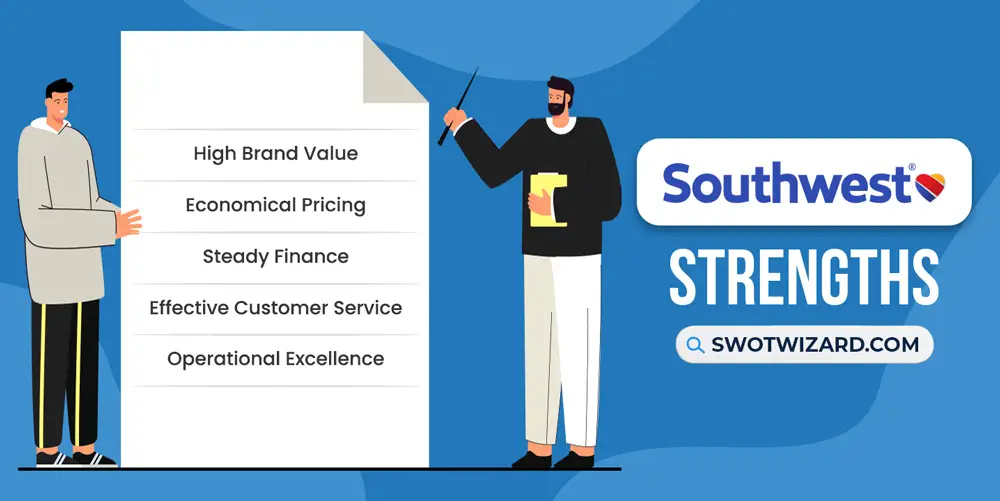
High Brand Value: Focusing on low fares, friendly customer service, and unique company culture has helped build a strong brand that resonates with customers. In 2022, the airline’s brand value was estimated at $7.3 B, a massive increase from the previous year and ranking as the world’s 4th most valuable airline brand.
Economical Pricing: By offering low fares for its flights compared to its competitors, Southwest Airlines has made a name for its economical pricing strategy. Southwest’s average domestic fare was $142 in 2022, lower than the average $397 for all U.S. airlines, which helped Southwest to remain a popular choice for budget-conscious travelers.
Steady Finance: The airline reported revenue of $23.8 B and a net income of $723 M in 2022. And the data shows this stable performance in the last few years, which is why it has maintained a positive cash flow , with $$11.049 B in operating cash flow, and the balance sheet remains strong.
Effective Customer Service: With a focus on providing passengers with a positive and friendly experience, Southwest Airlines is known for its excellent customer service. According to the various customer satisfaction Indexes, Southwest Airlines had a customer satisfaction score of 77 out of 100 in 2022, the second highest in the US airline industry.
Operational Excellence: The airline’s point-to-point system and efficient turnaround times have contributed to its success in providing customers with reliable and affordable air travel. According to the J.D. Power North America Airline Satisfaction Study, the airline ranked first in economy class with the lowest customer complaint rate.
Weaknesses – Southwest Airlines SWOT Analysis
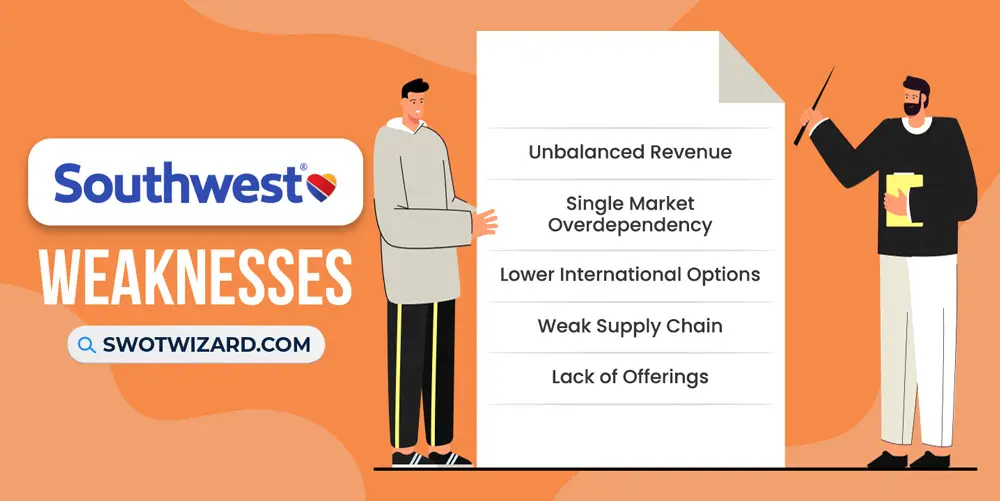
Unbalanced Revenue: The company is highly dependent on a single segment for revenue, the passenger, which covered over 80% of the total revenue in the last eight years. Besides, its niche-based offerings and focus on economical pricing have made it almost impossible for the company to keep a balanced revenue stream.
Single Market Overdependency: Southwest generated over 90% of its revenue from domestic operations in the USA, making it vulnerable to domestic economic and consumer behavior changes. It creates an overdependency on the market, limits the airline’s growth opportunities, and increases its exposure to domestic financial risks.
Lower International Options: Most of Southwest’s flights are domestic, with limited international destinations , making it hard to target a mass market. As a result, the overdependency on a single market, unbalanced revenue, and various threats and weaknesses are taking away many opportunities for the company.
Weak Supply Chain: Southwest Airlines has recently faced some supply chain challenges, particularly concerning its maintenance operations. The Federal Aviation Administration fined the company $325,000 for improperly maintained Boeing 737 aircraft, and recently, in 2022, the company had a severe SCM meltdown.
Lack of Offerings: The company has emphasized its commitment to providing affordable and reliable air travel, which comes at a cost. Because of that, the airline does not offer first-class seating, and its aircraft doesn’t have in-flight entertainment systems.
Opportunities – Southwest Airlines SWOT Analysis

Multidomestic Strategy: As mentioned, international flights accounted for approximately 7.7% of Southwest airline’s total revenue in 2022, so there are opportunities to expand internationally to more countries, focusing on a multi-domestic strategy. Finding new international routes and starting with them would be an excellent start.
Tech Adaptation: In recent years, the tech has disrupted and efficiently brought operational excellence and better customer experience. The company can implement self-service kiosks, mobile boarding passes, and other digital tools to streamline check-in and reduce customer wait times, and launching a new reservation system is part of the process.
Diversify Offerings: One opportunity for Southwest Airlines to continue to grow and expand its business is to diversify its offerings. As only a limited number of service offerings are available in the portfolio, the company can offer new services with different price sets. That will help to bring new consumer bases and increase revenue.
Sustainability Practices: To become a part of the sustainability practitioners, the company can recognize the importance of environmental responsibility and social impact. The airline has set a goal to reach carbon neutrality by 2050. It has implemented several initiatives, such as investing in more fuel-efficient aircraft and using sustainable aviation fuel .
Effective Partnerships: To expand the company’s reach and offer new services to customers, it has always tried to bring in new partnerships. The airline announced a partnership with Expedia in 2021. And recently, in 2022, the company partnered with a giant like Amazon to give the consumer a better experience.
Threats – Southwest Airlines SWOT Analysis
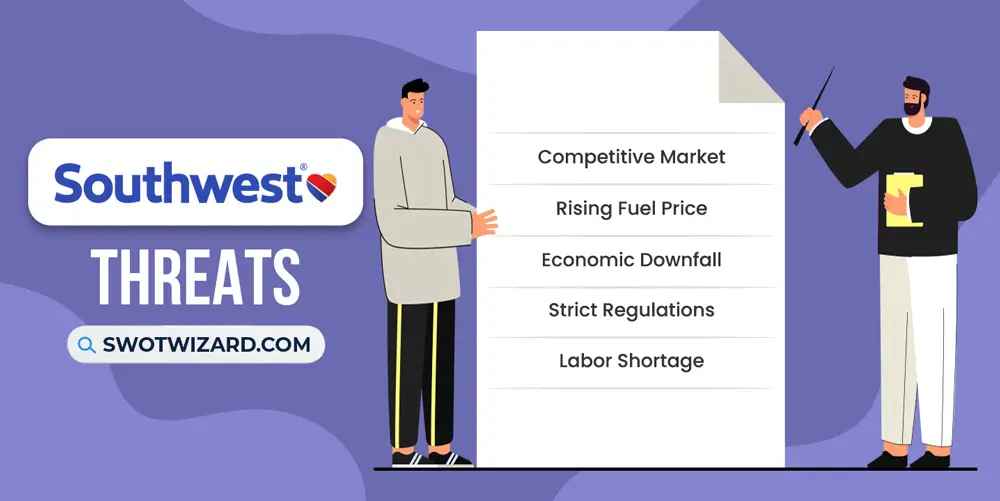
Competitive Market: Southwest Airlines faces intense competition in the U.S. airline industry with giant competitors such as Delta Air Lines, Spirit Airlines, American Airlines, and Frontier Airlines, etc. It had a market share of 17.1%, behind American Airlines (17.6%%), and a similar market share with Delta Air Lines (17.1%) in 2022.
Rising Fuel Price: Fuel is one of the most significant expenses for airlines, and rising prices can lead to increased operating costs and lower profitability. In 2022, the airline’s fuel costs were up 85% compared to 2021 and still increasing, a significant threat to Southwest Airlines.
Economic Downfall: Inflations and recessions or downturns can lead to decreased demand for air travel, as it did during the pandemic or 2008 recession, impacting Southwest Airlines’ revenue and profitability. As inflation already affects the airlines, the recession will make it difficult for Southwest Airlines to keep a stable cash flow in 2023.
Strict Regulations: Changes in government regulations or policies can significantly impact Southwest Airlines. The FAA grounded the Boeing 737 MAX aircraft following two fatal crashes, which affected Southwest Airlines’ operations in 2019. The grounding resulted in the cancellation of thousands of flights and negatively impacted the airline’s revenue.
Labor Shortage: As the recession hit the economy, many industries are on a streak of letting go of labor, which also impacted the airline industry. In December 2022, the company had to cancel 60% of the flights, a total of 2600 flights, because of labor shortage, including pilots to field workers, including staff in the headquarters.
[Bonus Infographic] SWOT Analysis of Southwest Airlines
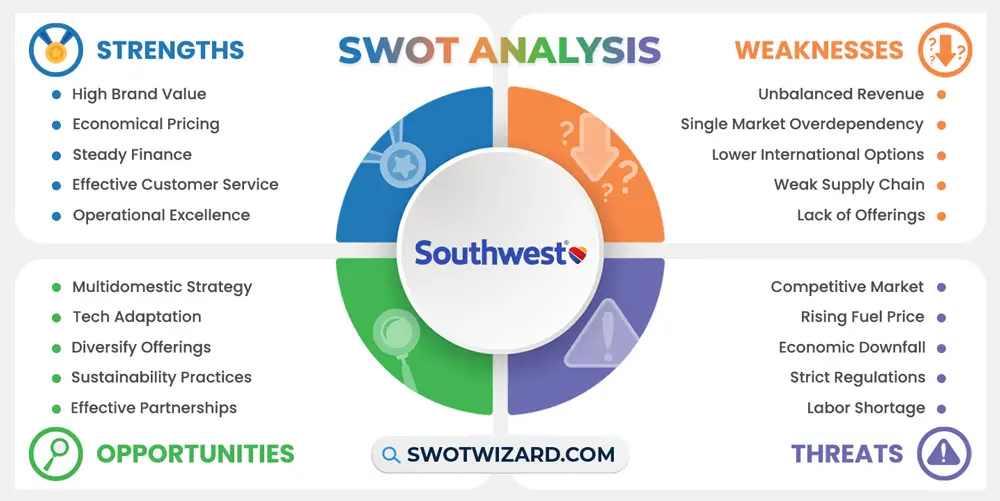
Recommendations for Southwest Airlines
Every company has to overcome all its weaknesses and mitigate threats to survive in the market long-term, and Southwest is no different. Here are some recommendations for them.
- Expanding its international offerings could help the company reach new customers, increase its revenue, reduce one market dependency, and balance the revenue stream.
- The company should continue to invest in employee retention and satisfaction.
- Exploring new partnerships and offerings that could help it to reach new customers.
- Adapting new techs will make the overall operations more effective and efficient.
- Practicing sustainability will create a positive impact on the consumer.
Frequently Asked Questions (FAQs)
What day is cheapest to fly on southwest airlines.
Tuesday is the cheapest day to fly on Southwest Airlines.
Is Southwest a Budget Airline?
Yes, Southwest is a budget airline.
Is Southwest an International Airline?
Yes, Southwest is an international airline.
Final Words on Southwest Airlines SWOT Analysis
Southwest Airlines is a significant player in the aviation industry, known for its commitment to affordable and reliable air travel. The company’s focus on operational efficiency and employee satisfaction has helped it to maintain low costs and a unique company culture that sets it apart from its competitors. While Southwest Airlines faces threats such as competitive pressure, regulations, rising fuel price, and a labor shortage, it has a track record of adapting and innovating to maintain its success.
- Wikipedia contributors. (n.d.). Southwest Airlines . Wikipedia.
- Second Quarter 2022 Average Air Fare Increases 22% from Second Quarter 2021 . (2022, October 18). Bureau of Transportation Statistics.
- O’Marah, K. (2022, December 30). Southwest Airlines Meltdown: A Supply Chain Management Perspective . Forbes.
- Banker, S. (2022, May 2). Southwest Airlines’ Flight Path To Carbon Neutrality . Forbes.
- Gabriele, A. (2023, March 9). Southwest Airlines Partners With Amazon After the Colossal Mess That Was Late 2022 . InsideHook.
- Pande, P. (2022, April 24). How Rising Jet Fuel Prices Will Hurt Airlines and Travelers . Simple Flying.
- Kulisch, E. (2022, June 1). Airline industry economist sees recession risk in 2023 . FreightWaves.
- Isidore, C. (2020, January 23). The 737 Max grounding cost Southwest $828 million in 2019 . CNN.
- Zilber, A. (2022, December 29). Southwest scrambles to fill key staff shortages with HQ workers, memo reveals . New York Post.
About The Author
Ahsanul Hauqe
Explore more swot analysis.
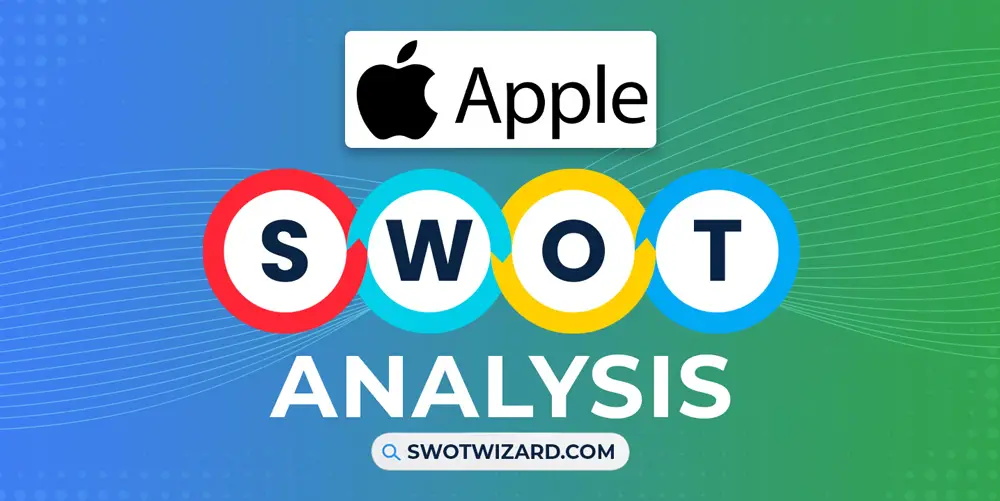
Apple SWOT Analysis 2024 : In-Depth Report With Infographics
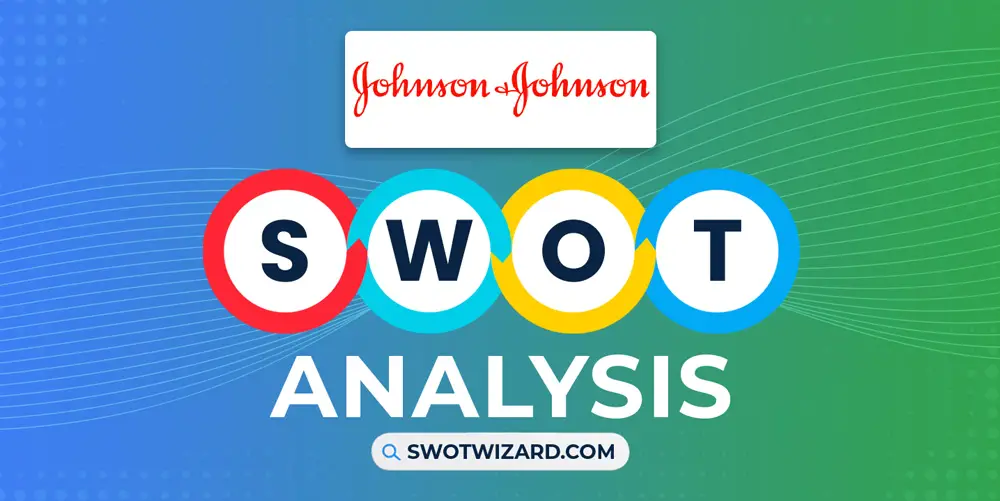
Johnson and Johnson SWOT Analysis 2024 With Key Insights
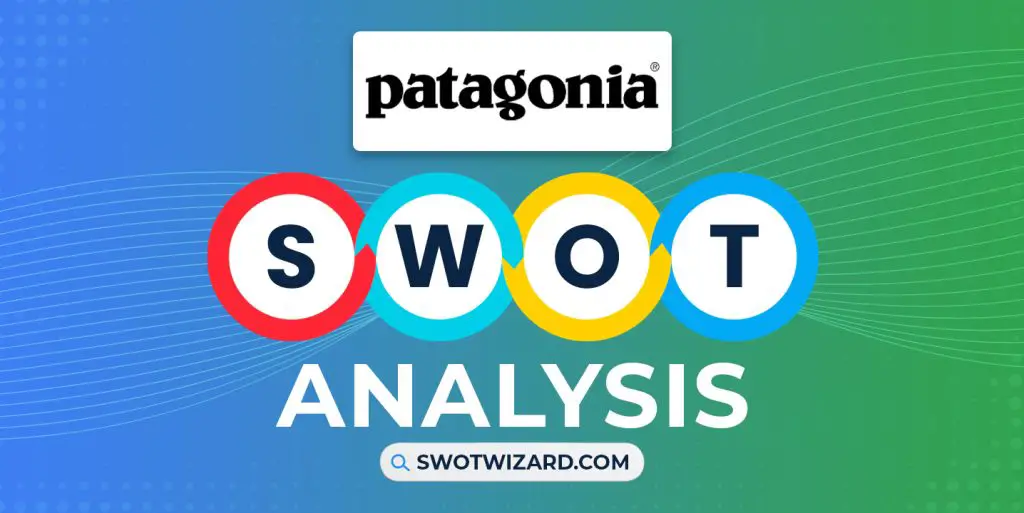
Patagonia SWOT Analysis 2023: Explore Its Competitive Edge
Leave a comment cancel reply.
Your email address will not be published. Required fields are marked *
Save my name, email, and website in this browser for the next time I comment.


Presentations made painless
- Get Premium
Southwest Airlines: Business Model, SWOT Analysis, and Competitors 2023
Inside This Article
Southwest Airlines is a renowned American low-cost carrier that has revolutionized the airline industry with its unique business model and customer-centric approach. In this blog article, we will delve into the intricacies of Southwest's business model, highlighting its key strengths, weaknesses, opportunities, and threats through a SWOT analysis. Additionally, we will explore the competitive landscape, identifying the major players that pose a challenge to Southwest's market dominance. Join us as we analyze Southwest Airlines' strategies and anticipate its position in the aviation industry in 2023.
What You Will Learn:
- Who owns Southwest Airlines and how its ownership structure may influence the company's decision-making process.
- The mission statement of Southwest Airlines and how it guides the company's strategic direction and customer service approach.
- How Southwest Airlines generates revenue and the key factors that contribute to its financial success.
- An explanation of the Southwest Airlines Business Model Canvas, which highlights the various components of the company's business model and how they work together.
- An overview of the main competitors of Southwest Airlines and how they compare in terms of market share, routes, and customer base.
- A SWOT analysis of Southwest Airlines, examining its strengths, weaknesses, opportunities, and threats in the competitive aviation industry.
Who owns Southwest Airlines?
Ownership structure of southwest airlines.
Southwest Airlines, one of the largest low-cost carriers in the world, has a unique ownership structure that sets it apart from many other airlines. The company operates under a publicly traded model, which means that its ownership is distributed among a diverse group of individual and institutional investors.
At present, the largest shareholders of Southwest Airlines are primarily institutional investors such as mutual funds, pension funds, and other financial institutions. These investors hold significant stakes in the company, often owning thousands or even millions of shares. Some of the major institutional shareholders of Southwest Airlines include The Vanguard Group, BlackRock, and State Street Corporation.
In addition to institutional investors, individual shareholders also play a crucial role in owning Southwest Airlines. Many individual investors, including employees of the company, hold shares of Southwest Airlines either directly or through retirement plans like 401(k)s. This broad base of individual ownership is a testament to the company's commitment to employee ownership and engagement.
It is worth noting that Southwest Airlines has a dual-class stock structure, with two different classes of shares: Class A and Class B. Class A shares are publicly traded and have voting rights, while Class B shares are mostly owned by Southwest Airlines' employees and have limited or no voting rights. This structure reflects the company's emphasis on employee participation and aligning their interests with those of the company.
Overall, Southwest Airlines' ownership is a balanced mix of institutional and individual investors, with both groups having a significant influence on the company's operations and decision-making. This diverse ownership structure helps ensure stability and fosters a long-term perspective, allowing Southwest Airlines to focus on delivering value to its shareholders while maintaining its reputation as a customer-centric airline.
What is the mission statement of Southwest Airlines?
Southwest airlines' mission statement.
Southwest Airlines is renowned for its unique mission statement, which is deeply ingrained in the company's culture and operations. The airline's mission statement can be summarized as follows:
"To connect people to what's important in their lives through friendly, reliable, and low-cost air travel."
Southwest Airlines places a strong emphasis on creating meaningful connections and providing exceptional customer service. By offering affordable air travel options, the company aims to enable individuals to reach their desired destinations while staying within their budget. Southwest strives to establish a warm and welcoming environment for its passengers, ensuring that their travel experience is not only hassle-free but also enjoyable.
The Core Values of Southwest Airlines
To fulfill its mission statement, Southwest Airlines upholds a set of core values that guide its actions and decision-making processes. These core values include:
Warrior Spirit: Southwest Airlines encourages its employees to have a warrior spirit, fostering a determination to overcome challenges and go above and beyond to serve customers. This value reflects the airline's commitment to excellence and continuous improvement.
Servant's Heart: Southwest Airlines believes in the importance of having a servant's heart, prioritizing the needs of others before its own. This value is reflected in the company's dedication to providing exceptional customer service and treating passengers with kindness and respect.
Fun-LUVing Attitude: Southwest Airlines promotes a fun-LUVing attitude among its employees, encouraging them to bring their authentic selves to work. This value fosters a positive and inclusive work environment, contributing to a vibrant and friendly atmosphere that passengers can sense during their journey.
Work the Southwest Way: Southwest Airlines emphasizes the significance of working the Southwest way, which means following established procedures while being open to innovation and creativity. This value ensures consistency and efficiency in operations while allowing for flexibility and adaptability to meet customer needs.
By adhering to these core values, Southwest Airlines strives to create a unique and exceptional travel experience for its passengers, setting itself apart from other airlines in the industry.
How does Southwest Airlines make money?
Ticket sales.
The primary source of revenue for Southwest Airlines is ticket sales. Passengers purchase tickets for flights, which generate income for the company. Southwest offers a variety of fare options, including Business Select, Anytime, and Wanna Get Away, allowing customers to choose the level of service and flexibility that best suits their needs. By offering competitive prices, Southwest attracts a large customer base, ensuring steady revenue from ticket sales.
Ancillary Revenue
In addition to ticket sales, Southwest Airlines generates significant income from ancillary revenue. Ancillary revenue refers to the revenue earned from services and products that are not directly related to the core air travel experience. Southwest offers several ancillary services, such as EarlyBird Check-In, which allows passengers to secure a better boarding position for an additional fee. The airline also earns revenue from the sale of in-flight snacks, beverages, and merchandise. These additional revenue streams contribute to Southwest's overall profitability.
Rapid Rewards Program
Southwest Airlines' Rapid Rewards Program plays a crucial role in generating revenue for the company. This loyalty program incentivizes customers to fly with Southwest by offering points for each flight. Accumulated points can be redeemed for free flights, hotel stays, rental cars, and other rewards. The Rapid Rewards Program encourages repeat business and fosters customer loyalty, ultimately leading to increased ticket sales and revenue for Southwest Airlines.
Cargo and Freight Services
Beyond passenger transportation, Southwest Airlines offers cargo and freight services to generate additional income. The company leverages its extensive network of flights and destinations to transport goods and packages efficiently. Southwest Cargo provides reliable and cost-effective shipping solutions for businesses and individuals alike. By tapping into the demand for cargo transportation, Southwest expands its revenue streams and diversifies its income sources.
Partnerships and Codeshare Agreements
Southwest Airlines also generates revenue through partnerships and codeshare agreements with other airlines. These agreements allow Southwest to extend its reach and offer customers a wider range of travel options. By collaborating with partner airlines, Southwest can sell tickets on routes not served by its own fleet. In return, Southwest earns a portion of the revenue from these codeshare flights. This strategic partnership approach helps Southwest Airlines increase its market share and boost its revenue.
In conclusion, Southwest Airlines generates revenue primarily through ticket sales, supplemented by ancillary services, the Rapid Rewards Program, cargo and freight services, as well as partnerships and codeshare agreements. These diverse income streams contribute to the company's financial success and enable Southwest to remain competitive in the aviation industry.
Southwest Airlines Business Model Canvas Explained
Introduction to the southwest airlines business model canvas.
The Southwest Airlines Business Model Canvas serves as a comprehensive framework for understanding the key components of the airline's business model. Developed by Alexander Osterwalder, this tool provides a visual representation of an organization's strategy, value proposition, customer segments, revenue streams, and more.
Key Partnerships
One of the fundamental elements of Southwest Airlines' business model is its strategic partnerships. By collaborating with various stakeholders, the airline is able to enhance its services and expand its reach. Southwest has built strong relationships with aircraft manufacturers, such as Boeing, to ensure a reliable and efficient fleet. Additionally, the airline has formed partnerships with hotels, car rental companies, and other travel service providers to offer bundled packages and increase customer convenience.
Key Activities
Southwest Airlines' key activities revolve around providing reliable and low-cost air travel. These activities include flight operations, maintenance and servicing of aircraft, customer service, and marketing. The airline focuses on operational efficiency, quick turnaround times, and streamlined processes to reduce costs and deliver high-quality services to its customers.
Key Resources
To support its key activities, Southwest Airlines relies on several key resources. The most critical resource is its fleet of aircraft, which enables the airline to operate its flights. Additionally, Southwest invests in highly skilled pilots, flight attendants, and ground staff who contribute to the smooth functioning of the airline. The company's extensive network of airports, maintenance facilities, and reservation systems also play a crucial role in its operations.
Value Proposition
Southwest Airlines' value proposition centers around its commitment to providing low-cost, reliable, and customer-centric air travel. The airline differentiates itself by offering low fares, no baggage fees, and a hassle-free experience. Southwest's open seating policy and friendly customer service contribute to a unique and enjoyable flying experience. By focusing on these elements, the airline aims to attract price-sensitive customers and build long-term relationships with loyal passengers.

Customer Segments
Southwest Airlines primarily targets leisure and business travelers who prioritize affordability and convenience. The airline caters to a broad customer base, including families, solo travelers, small businesses, and frequent flyers. By understanding the needs and preferences of these customer segments, Southwest tailors its services and marketing efforts to deliver maximum value and create customer loyalty.
Revenue Streams
The main revenue stream for Southwest Airlines is ticket sales. The airline generates income by selling flight tickets directly to customers through its website, mobile app, and customer service centers. In addition to ticket sales, Southwest also earns revenue through ancillary services such as onboard food and beverage sales, Wi-Fi access, and early boarding options. By diversifying its revenue streams, Southwest minimizes its dependence on a single source of income.
The Southwest Airlines Business Model Canvas provides a comprehensive overview of the key components that drive the airline's success. By focusing on strategic partnerships, delivering a unique value proposition, targeting specific customer segments, and diversifying its revenue streams, Southwest has established itself as a leading low-cost carrier in the industry. Understanding and leveraging these elements within the Business Model Canvas framework can help other businesses analyze and optimize their own strategies for success.
Which companies are the competitors of Southwest Airlines?
Introduction.
Southwest Airlines, known for its low-cost model and exceptional customer service, operates in a highly competitive industry. While Southwest has managed to carve out a niche for itself, it faces fierce competition from various companies within the airline industry. In this section, we will explore some of the major competitors of Southwest Airlines.
Delta Air Lines
Delta Air Lines is one of the largest airlines globally and a significant competitor of Southwest Airlines. With a wide network of domestic and international routes, Delta offers a range of services catering to different customer segments. Delta Air Lines focuses on providing premium services, including extensive in-flight entertainment options, comfortable seating arrangements, and a broad range of travel classes. This emphasis on luxury and comfort sets Delta apart from Southwest, which primarily focuses on no-frills, budget-oriented travel.
American Airlines
American Airlines, another major competitor of Southwest Airlines, offers an extensive network of domestic and international flights. American Airlines targets a wide range of customer segments, including both leisure and business travelers. With a broader range of travel classes, including first-class and business-class options, American Airlines caters to passengers seeking a more luxurious travel experience. This differentiation allows American Airlines to compete with Southwest Airlines, appealing to customers who prioritize comfort and amenities over cost.
United Airlines
United Airlines is a leading global airline and a formidable competitor for Southwest Airlines. Operating an extensive network of domestic and international routes, United Airlines offers a range of services catering to both leisure and business travelers. With a focus on providing a premium travel experience, United Airlines offers various travel classes, including first-class and business-class options. Additionally, United Airlines has a strong presence in major hub airports, allowing them to offer a wider range of connecting flights. This strategic advantage enables United Airlines to compete directly with Southwest Airlines, especially on routes where nonstop flights are not available.
JetBlue Airways
JetBlue Airways, while not as large as some of the other competitors mentioned, is a notable low-cost airline that competes directly with Southwest Airlines. Similar to Southwest, JetBlue focuses on offering affordable fares and exceptional customer service. Both airlines have a similar no-frills approach, providing a simplified travel experience without charging extra fees for services like checked bags. JetBlue Airways primarily operates in the domestic market but offers a limited number of international flights. This overlap in target market and business model makes JetBlue a direct competitor of Southwest Airlines.
In the fiercely competitive airline industry, Southwest Airlines faces significant competition from various companies. Delta Air Lines, American Airlines, United Airlines, and JetBlue Airways are among the major competitors that challenge Southwest's market position. Each of these airlines differentiates itself by offering varying levels of luxury, a broader network of routes, or a combination of both. Despite the competition, Southwest Airlines continues to thrive by focusing on its core strengths of low-cost fares, excellent customer service, and efficient operations.
Southwest Airlines SWOT Analysis
Strong brand reputation: Southwest Airlines has built a strong brand reputation over the years, known for its customer-friendly policies, low fares, and excellent customer service. The company has consistently ranked high in customer satisfaction surveys, leading to customer loyalty and repeat business.
Extensive domestic network: Southwest Airlines operates an extensive domestic network, serving more than 100 destinations across the United States. This wide coverage allows the airline to attract a large customer base and capture a significant market share.
Cost leadership: Southwest Airlines has a reputation for offering low fares compared to its competitors. The airline has implemented cost-saving measures, such as using a single aircraft type (Boeing 737) to simplify operations and reduce maintenance costs. This cost leadership strategy enables Southwest Airlines to attract price-sensitive customers and maintain a competitive edge in the market.
Limited international presence: Unlike some of its competitors, Southwest Airlines has a limited international presence. The airline primarily focuses on domestic flights, which could be a strategic disadvantage in an increasingly globalized market. This limitation may result in missed opportunities to tap into the growing international travel market.
No first-class or business-class seating: Southwest Airlines operates with a single-class configuration, offering no first-class or business-class seating options. While this helps in maintaining simplicity and reducing operational costs, it may deter high-end business travelers who prefer premium seating and services. This could limit the airline's potential to attract a certain segment of customers.
Dependency on the US economy: Southwest Airlines' performance is closely tied to the health of the US economy. Economic downturns, such as recessions, can lead to reduced air travel demand, affecting the airline's profitability. This dependency on a single market makes Southwest Airlines vulnerable to economic fluctuations.
Opportunities
International expansion: Southwest Airlines has the opportunity to expand its international presence and tap into the growing global travel market. By adding more international routes and partnerships with foreign airlines, the company can attract a wider customer base and increase revenue streams.
Technological advancements: The airline industry is constantly evolving with technological advancements. Southwest Airlines can leverage technology to enhance its operational efficiency, improve customer experiences, and streamline processes. For example, implementing self-service kiosks, mobile apps for booking and check-in, and utilizing data analytics for personalized marketing can give Southwest Airlines a competitive advantage.
Growing demand for sustainable travel: With increasing awareness of environmental issues, there is a growing demand for sustainable travel options. Southwest Airlines can seize this opportunity by implementing eco-friendly practices, such as investing in fuel-efficient aircraft, adopting sustainable fuel alternatives, and reducing carbon emissions. This can attract environmentally conscious travelers and enhance the airline's reputation.
Intense competition: The airline industry is highly competitive, with numerous airlines vying for market share. Southwest Airlines faces competition from both legacy carriers and low-cost carriers, which may lead to price wars and reduced profitability. The intense competition can also result in decreased customer loyalty, as customers have a wide range of options to choose from.
Fluctuating fuel prices: Fuel prices are a significant cost component for airlines. Fluctuations in fuel prices can significantly impact Southwest Airlines' operating expenses and profitability. Volatile fuel prices make it challenging for the airline to accurately forecast and plan its financials, posing a constant threat to its bottom line.
Regulatory challenges: The airline industry is subject to various regulations, including safety, security, and labor regulations. Compliance with these regulations can be costly and time-consuming. Changes in regulations or the introduction of new regulations can pose challenges for Southwest Airlines' operations and increase compliance costs.
By conducting a SWOT analysis, Southwest Airlines can identify its strengths, weaknesses, opportunities, and threats, enabling the company to formulate effective strategies to leverage its strengths, mitigate weaknesses, seize opportunities, and manage threats in the ever-changing airline industry.
Key Takeaways
- Southwest Airlines is owned by its shareholders, with no single majority owner. The largest shareholders include institutional investors and mutual funds.
- The mission statement of Southwest Airlines is to "dedicate ourselves to the highest quality of customer service delivered with a sense of warmth, friendliness, individual pride, and company spirit."
- Southwest Airlines primarily makes money through ticket sales, as well as various ancillary sources such as baggage fees, in-flight services, and partnerships with other companies.
- The Southwest Airlines Business Model Canvas is a strategic management tool that outlines the key elements of Southwest's business model, including its customer segments, value proposition, channels, revenue streams, key activities, resources, and partnerships.
- The main competitors of Southwest Airlines include other major US airlines such as Delta Air Lines, American Airlines, and United Airlines. However, Southwest differentiates itself through its low-cost, point-to-point, and customer-centric approach.
- Southwest Airlines SWOT Analysis reveals its strengths (strong brand reputation, low-cost structure), weaknesses (limited international presence, dependence on US market), opportunities (expansion into new markets, partnerships), and threats (competition, fuel prices, economic downturns).
In conclusion, Southwest Airlines is owned by a diverse group of shareholders, including institutional investors and individual stakeholders. The mission statement of the airline is to provide the highest quality of customer service, while maintaining a focus on employee welfare and profitability.
Southwest Airlines generates revenue through various sources, such as ticket sales, additional services, and partnerships. Their business model canvas is built upon key elements like low-cost operations, customer-centricity, and a strong corporate culture.
As for competitors, Southwest Airlines faces competition from major carriers like Delta, American Airlines, and United Airlines. However, its unique positioning as a low-cost airline with a strong focus on customer satisfaction sets it apart from the competition.
A SWOT analysis of Southwest Airlines reveals its strengths, including a robust brand image, efficient operations, and a loyal customer base. However, it also faces challenges such as increasing competition, fluctuating fuel prices, and potential labor disputes. By leveraging its strengths and addressing its weaknesses, Southwest Airlines aims to remain a leading player in the airline industry.
In summary, Southwest Airlines is a well-established airline with a strong mission statement and a successful business model. While facing competition from major carriers, it continues to thrive by delivering exceptional customer service, maintaining cost-effective operations, and adapting to the ever-changing industry landscape.
Want to create a presentation now?
Instantly Create A Deck
Let PitchGrade do this for me
Hassle Free
We will create your text and designs for you. Sit back and relax while we do the work.
Explore More Content
- Privacy Policy
- Terms of Service
© 2023 Pitchgrade
Southwest Airlines SWOT: Financial strength is mainstay, but cost and culture challenges loom large
At 43 years of age, Southwest Airlines is firmly entrenched in middle age within a mature US market place. During its more than four decades the airline has largely retained its appeal and perpetuated its renegade image, even if that perception is now more legend than reality. As its merger integration with AirTran comes to a close, Southwest continues to exploit its domestic strength by forging a presence in key US markets while laying the groundwork to bolster its international offerings in 2015 with service from a new international terminal at its sixth largest base measured by seats deployed, Houston Hobby . But even as it still engenders positive customer sentiment, Southwest faces numerous challenges. These include preserving its culture and finding new ways to generate revenue. At the same time it is becoming more difficult for Southwest to brandish its low fare image with the rise of ultra low-cost airlines that are fulfilling Southwest 's traditional role - traffic stimulation through rock bottom fares.
- Southwest Airlines has sustained profitability and has a strong balance sheet, making it financially stable.
- The airline has a well-known and recognized brand, which provides differentiation in a competitive market.
- Southwest has a robust domestic network and a strong presence in key US markets.
- The airline faces challenges in generating revenue and maintaining its low fare image in the face of competition from ultra low-cost carriers.
- Opportunities for Southwest include the repeal of the Wright Amendment, allowing for direct flights from its Dallas Love Field base, and the expansion of international operations.
- Threats to Southwest include the rise of ultra low-cost carriers and increasing costs due to labor negotiations, which could erode the airline's unique culture.
Southwest Airlines Strengths
1. financial wherewithal.
During 2Q2014 Southwest recorded its fifth consecutive quarter of record profits. Its consistent profitability and balance sheet strength have resulted in the airline holding the position of the only US airline to achieve investment grade status until Alaska Air Group secured that coveted position earlier in 2014. Southwest managed to remain profitable during the financial downturn of 2008 and 2009, and its CY2013 profits of USD754 million were the highest recorded by the airline since 2008.
Southwest Airlines Co . annual net profit (loss): 2008 to 2013
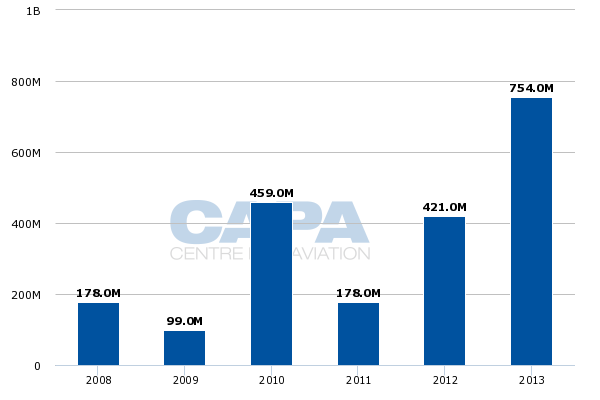
Source: CAPA - Centre for Aviation and airline reports
Growth of Southwest Airlines Co . annual net profit (loss): 2009 to 2013
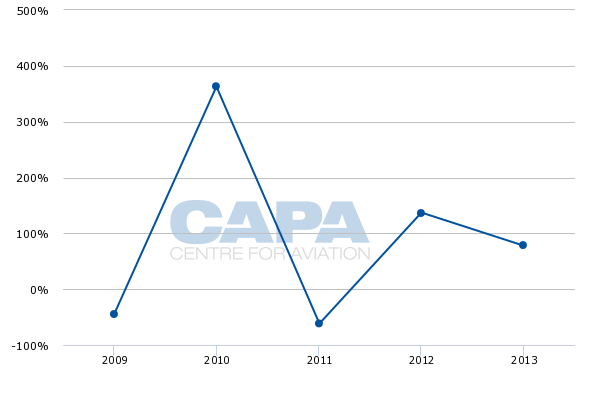
At the same time Southwest has sustained a measurably strong balance sheet. Its leverage at the end of 2Q2014 was 37%, and its cash in hand was USD4 billion. During 1H2014 it generated USD1.6 billion of free cash flow, and as of 30-Jun-2014 Southwest had reduced its debt and capital lease obligations by USD1.5 billion.
2. Southwest has an iconic brand
Southwest is one of the most recognised brands in the US , and it consistently works to exploit its heritage through advertising during high profile sporting events and in social media. It has been deemed the top travel brand and fifth overall brand by The Business Journals in the American Brand Excellence Awards.
This provides important differentiation in a commoditised industry. Standing out by not going along with the crowd and forgoing the revenue is arguably a net gain, albeit perhaps not easily accountable.
3. It maintains a robust domestic network
Presently Southwest is benefitting from strong demand within the US market place, reflected in its 8% passenger unit revenue growth in 2Q2014, the largest gain of any US airline. Based on data from CAPA and OAG for the week of 15-Sep-2014 to 21-Sep-2014 Southwest is the second largest airline in the US domestic market measured by seat deployment. Its share is approximately 20% behind Delta 's nearly 22% share.
United States of America capacity by airline (% of seats): 15-Sep-2014 to 21-Sep-2014
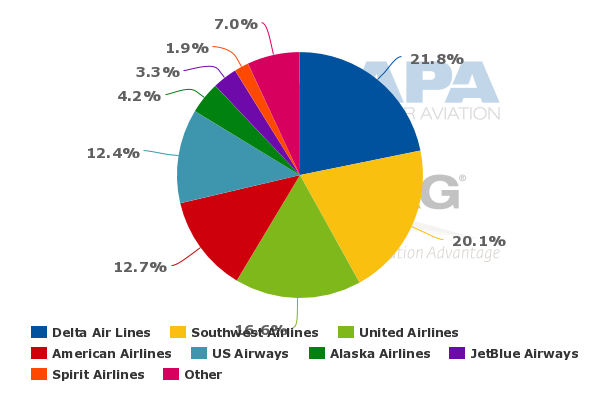
Source: CAPA - Centre for Aviation and OAG
Through its acquisition of AirTran and seizing on required slot divestitures by American and US Airways in order for those airlines to move forward with their merger, Southwest has made inroads in the key US markets of Washington National and New York LaGuardia .
As a result Southwest has a relatively strong position in eight of the top 10 US cities by arrivals for the week of 15-Sep-2014 to 21-Sep-2014: Chicago (it holds an 88% seat share at Midway ), Atlanta (second largest with a 7% share, Delta retains an 80% share), New York LaGuardia (fourth largest airline with an 8% share), Denver (second largest airline with a 26% share), Los Angeles (a highly fragmented market where Southwest retains a 13% seat share), Houston (a 91% seat share at Hobby), Las Vegas ( Southwest holds a 43% share) and Washington (a nearly 9% share at Washington National and a 70% share at Baltimore/Washington International) (All information is based on data from CAPA and OAG .)
United States of America top 10 domestic cities by arrivals: 15-Sep-2014 to 21-Sep-2014
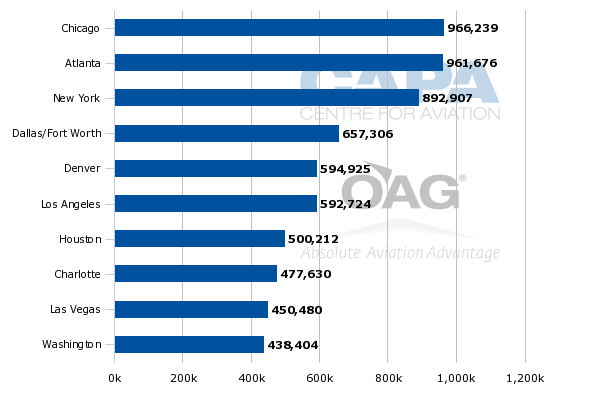
Southwest Airlines global top 10 hubs/bases/stations by seats: 15-Sep-2014 to 21-Sep-2014
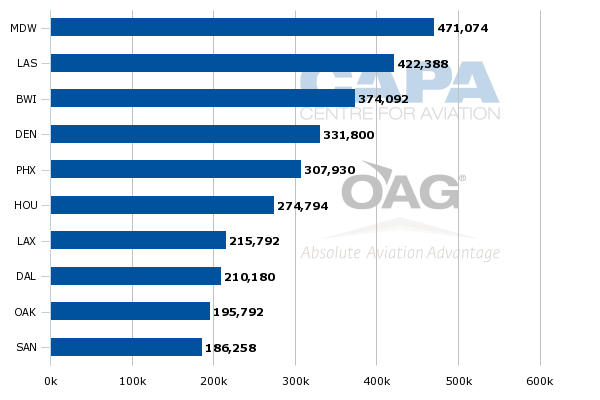
Southwest Airlines Weaknesses
1. minimal revenue opportunities.
Southwest has rejected the product unbundling that nearly all of its US counterparts have undertaken that airlines tout is designed to allow customers to tailor their experiences. The reality is for most airlines - full service, hybrid, and ultra low-cost - ancillary revenue presents the largest opportunity to grow revenue significantly over the medium and long term. The airline's top-line revenues increased just 3.6% year-on-year during CY2013 after peaking at 29% growth in CY2011.
Growth in Southwest Airlines Co . annual operating revenue: 2009 to 2013
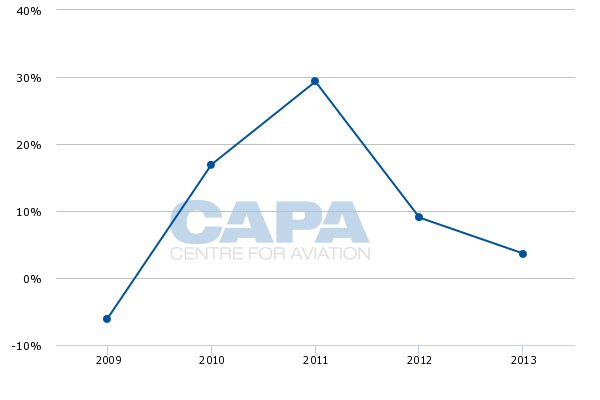
Southwest has attempted to pull some ancillary levers in its own, usually more positive way - selling select boarding positions at the gate, tightening flexibility around its most restrictive fares and increasing some other fee revenue. During 2013 the airline estimated that those changes would result in roughly USD175 million of incremental revenue on an annual basis. See related report: Southwest Airlines plots course to meet previously missed ROIC targets Southwest transported roughly 133 million enplaned passengers in CY2013, and its revenues outside freight and passenger operations fell 2.5% to USD815 million. US hybrid airline JetBlue carried 30 million passengers in CY2013; but recorded ancillary revenue of USD670 million in CY2013, of which USD170 million was derived from its Even More offering (extra legroom, priority boarding and in some cases expedited security clearance). Also a customer favourite, JetBlue has successfully grown its ancillary revenue through creating products customers value rather than making passengers feel nickel and dimed. It is not a stretch to conclude Southwest could create some added value for its legions of fans.
2. Its product is outdated
Southwest has the balance sheet strength to leverage new products that its customers would find appealing, and that in the medium term would generate high margin revenue. An extended legroom offering is now the norm for numerous airlines worldwide (including many ULCCs), and offers an opportunity to drive up ancillary revenue. Southwest has actually densified its aircraft (and decreased seat pitch) during the past couple of years - another trend apparent in the US industry. But other than offering onboard Wi-Fi, its product is arguably stale, and more importantly, it could be missing an opportunity to leverage its strong brand to create new revenue opportunities.
Southwest Airlines Opportunities
1. wright amendment repeal.
During Oct-2014 all restrictions on long-haul flying from Southwest 's Dallas Love Field base will be dissolved, allowing Southwest to offer direct flights to many of its strongest markets without the need for connecting service.
Initially Southwest is operating service to Baltimore , Denver , Las Vegas , Orlando and Chicago Midway . Other new service includes flights to Atlanta , Fort Lauderdale , Los Angeles, Nashville, LaGuardia , San Diego , Orange County, Tampa and Washington National . See related report: Southwest Airlines wins Love - but also new competitive forces with repeal of Wright Amendment Given its favourable positioning in all of those markets the new direct flights from Love Field should spool up quickly and make a positive revenue contribution to the airline's already strong results.
2. New international operations
Southwest introduced its own-branded international service during 2014 after many years talking about expanding to adjacent international markets. The AirTran acquisition and a reservations system upgrade have helped accelerate the process and now Southwest offers service to Aruba , Cancun , Los Cabos, Nassau , Montego Bay and San Juan. The airline marks an important milestone in late 2015 when it launches international flights from Houston Hobby after successfully beating back opposition from United ( Houston Intercontinental's largest airline) over the construction of a new international terminal at Hobby. The addition of international service is important network diversification for Southwest as it has arguably penetrated most of the domestic US (85 domestic destinations as of 21-Sep-2014). Its ability to offer its large passenger base access to near international leisure destinations is a natural progression, and should create some revenue upside once the markets reach maturity.
3. Potential partnerships with foreign international airlines
A recent study by CAPA identified a number of US airports which are currently underserved by foreign airlines. Southwest is frequently the dominant airline at the airport, operating only domestic services.
See related story:
787 and A350 airline operators will open up new Europe-US routes - despite some inertial resistance
There are many examples of independent LCCs and other airlines in such circumstances establishing partnerships and extensive codeshares with foreign carriers which need feed behind their initial gateway. For various reasons, including opposition from some employee groups, Southwest has not entertained such possibilities. There is substantial opportunity for enhanced traffic flows in these relationships.
Southwest Airlines Threats
Contrary to its claims, Southwest is no longer the low fare leader as Spirit Airlines , Frontier Airlines and Allegiant Air overtake the historical Southwest role of using low fares to stimulate air travel. During CY2013 its average fare increased 7%, and nearly 6% in 1H2014. Some of that was due to strong demand within the US market place; but the reality is Southwest needs to maintain certain fare levels to manage its costs. The rise of ULCCs is arguably creating an identity crisis for Southwest . The airline is no longer really low-fare or low-cost, but does not offer any of the amenities of hybrid or full service airlines. Southwest argues that not neatly fitting into a mould is part of its renegade image. Yet staying stuck in a 43-year old mindset stifles innovation, which is something Southwest needs to focus on in order to remain relevant in the long term.
2. Costs are rising and likely to rise further
Southwest is in the midst of numerous labour negotiations that are making it tough to predict its unit cost increases in the medium to long term. For the moment its unit costs are in line with major airlines, rising 2% in 1H2014 as passenger unit revenues grew a healthy 6% during that time. But the airline will inevitably endure some cost pressure as new contracts take effect after tense negotiations. Southwest has previously acknowledged that its labour agreements are built on an operating model it executed 10 to 15 years ago, and the airline has one of the highest pay structures in the industry. For CY2013 salaries, wages and benefits represented 31% of the airline's total top-line expenses. See related report: Southwest Airlines: solid financial performance for FY2013, but challenges are piling up
3. A unique culture is being eroded
The push and pull of the labour negotiations has already created cracks in Southwest 's favourable employee relations and its culture. In early 2014 the union representing ramp workers sued Southwest after the airline requested that employees at Chicago Midway prove they were ill during Jan-2014 after inadequate staffing and a winter storm triggered operational disruptions at the airport. Illustrating the pressure Southwest faces in its employee relations the union representing ramp workers in early 2014 warned: "By refusing to reward employees for their contribution to our airline's success, management is taking a terrible wrong turn from Southwest Airlines ' past emphasis on putting employees first and maintaining positive labor relations."
There appears to be a substantial rift emeging between employees seeing a commonality of purposes with the company and pursuing their own interests.
Outlook: Southwest 's competitiveness remains solid; but cracks are starting to emerge
The strong domestic environment within the US is helping Southwest to sustain an undeniably strong financial position, and the lifting of the Wright Amendment and new international service should help keep its passenger revenues robust. But Southwest needs to define itself for the long term in light of the rise of ULCCs and the product evolution taking place within the industry. Perhaps the most renegade change it needs is for its "family" to undertake a mindset change.
Want More Analysis Like This?

Southwest Airlines SWOT Analysis
Overview of southwest airlines, single type aircraft, constant profits, large capacity, many flights, dominant market share, operational costs affecting net income, lack of commercial alliances, overdependence on boeing 737s, passenger amenities, supply chain, outdated product, limited international operations, increase freight business, grow global tourism, expand globally, offering long distance flights, ultra-low-cost airlines, heavy regulation, competition, negative publicity, question: can i change my flight with southwest airlines, question: what are the cancellation policies at southwest airlines, question: what size should my carry-on be, question: what are travel funds.
The airline industry is tricky, as seen from some of the challenges the major players in this niche face. However, the challenges rock across the industry, but the players still manage to remain afloat and facilitate travel across the globe. In this piece, we will break down a popular domestic carrier in the United States and present a SWOT analysis to see the positive and negative side of it.
Southwest Airlines is one of the leading airline companies in the US. In 2018, it recorded the highest number of enplaned passengers in the US. It operates across all the 40 states and 15 international destinations in 12 countries. In 2018 alone, the airline carried 163.6 million passengers.
Unlike its competitors, who follow a hub and spoke model for their operations, Southwest Airlines follows a point-to-point service mode l. This makes the company stand out not only in customer service but also in its price leadership.
The company was established in 1971 by Rollin King and Herb Kelleher. The current CEO of the airline is Gary Kelly, and its headquarters are in Dallas, Texas. In 2019, the company had employed 60,800 employees and had a net income of $2.3 billion.
The main focus of the company is its operational efficiency which aims to reduce costs. To maintain the operational costs and fuel prices, the company only uses the Boeing 737 aircraft. The airline company has nearly 750 units of this aircraft in its fleet.
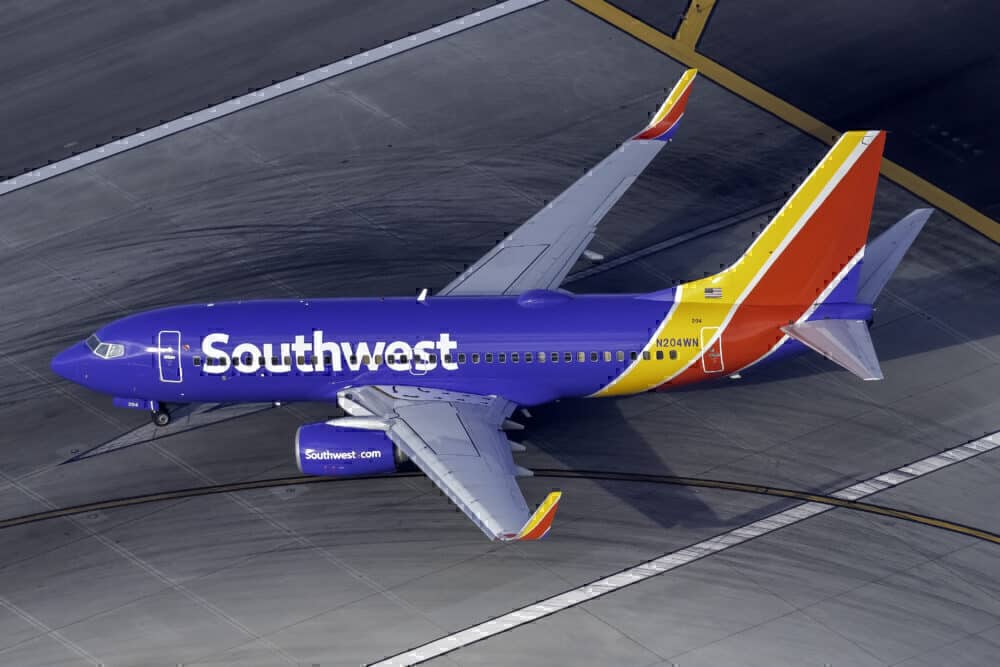
Southwest Airlines has been exclusively using Boeing 737s for all its flight operations since its inception. It currently has around 750 Boeing 737s. Using a single type of aircraft for flights is cheap and effective. It makes it easy to train the staff, ground crew, and pilots since their focus is on this model, and they can quickly learn how to operate and maintain them. This unified approach makes them experts on the Boeing 737, which drives efficiency in the long run.
One essential aspect of running a business is generating enough profits to sustain it and drive growth. They are a good foundation for companies that seek to build a considerable capital base for expansion. Southwest Airlines has recorded profits for 47 consecutive years up to 2019. Keeping in mind that airlines are a cutthroat industry, gaining profits for such a long period is recognizable.
In airlines, capacity is measured in terms of Available Seat Miles (ASMs). A successful airline should have a higher ASM. If the ASM is high, it means there are more seats for longer miles. The ASM of Southwest has grown from 120.58 billion in 2011 to 157.25 billion in 2019. The growth has made the company to be one of the few airlines with high capacity.
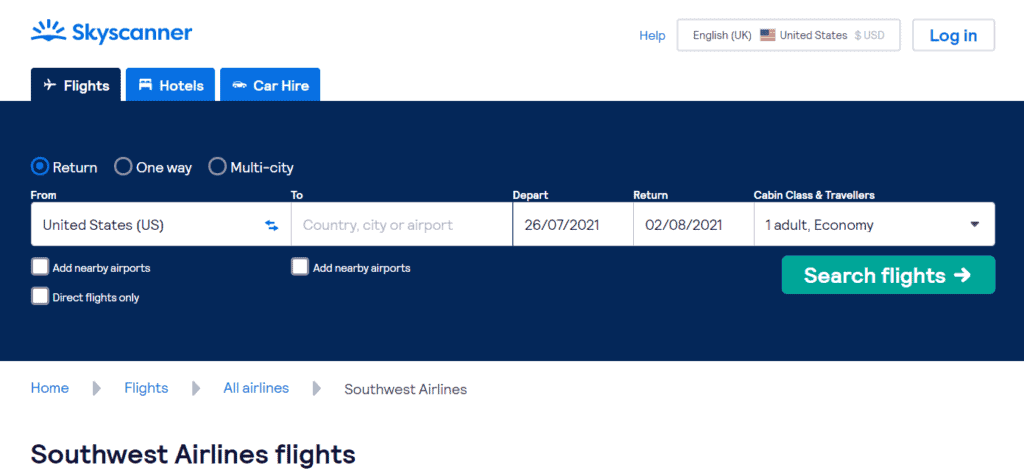
A large number of loyal customers Southwest Airlines has can be attributed to its low-cost flights . The airline has a low fare calendar. Passengers can book flight tickets for as low as $45 on the calendar for a one-way flight. Southwest has held the title of offering cheap flight costs for a while.
The more an airline flies, the more revenue is generated. Southwest Airlines operates over 4000 flights in a day during the peak season. Such a high number of flights makes Southwest a force to reckon in the airline industry.
Airlines are influenced by intense lobbying, and the dominant ones benefit a lot. By being a dominant player in the market share, an airline can leverage its resources, superiority, and connections to lobby the successful adoption of laws that favor its agenda.
Southwest airlines have a US domestic market share of 16.8%, making it rank third. The first and second are the American and Delta airlines with 17.6% and 17.5%, respectively.
Southwest Airlines has attracted more customers than its rivals by reducing costs. But it has to focus on improving fuel efficiency and other areas where it can reduce costs. In 2020, the operating expenses of the company grew compared to 2019. This airline can improve its profit margin by cutting costs and getting enough resources needed to diversify or improve operations.
Most of Southwest Airlines’ competitors have established commercial relationships. These relationships boost them since they provide more destinations to their patrons than Southwest Airlines. By looking for more commercial alliances, the airline can expand its destination network, which will set it up to further growth.

Southwest airlines have been using Boeing 737s since its inception. In March 2019, the Federal Aviation Administration issued an emergency to ground all Boeing Max aircraft after two fatal accidents. Out of its 750 Boeing planes, Southwest has 31.
This led to fewer operating planes and, in return, lost revenue. This highlights how wrong it is to depend on only one aircraft model.
As we talk of reliance on one craft model, it is also notable that this policy limits passenger amenities to what is available in Boeing 737 alone. Competing airline companies operate aircrafts with better passenger amenities and a larger carrying capacity.
For example, Southwest Airlines does not offer premium seating facilities during flights like business class or first class.
Boeing is the leading company supplying Southwest Airlines with spare parts. With such arrangements, there is always an impending risk of supply chain bottlenecks. It is essential to diversify the supply chain so that any issue affecting Boeing cannot be cascaded to Southwest Airlines. The long delays in restoring the fleet of Boeing Max highlight the problem of Southwest’s total reliance on Boeing.
Southwest Airlines should develop new products for its customers. In recent years, the company densified its aircraft by decreasing the seat pitch. Besides the densification and offering onboard WiFi, the company could be missing out on a chance to leverage its strong brand to come up with new revenue opportunities. This is important to diversify its offering and keep customers happy, which will eventually boost revenues.

Southwest Airlines is a domestic operator in 40 states in the US. It only offers its services to a limited number of international destinations like Caicos, Turks, Cayman Islands, Cuba, Belize, Costa Rica, Dominican Republic, Aruba, and the Bahamas. When compared to Delta Airlines, its competitor, these are just a drop in the ocean.
Delta Airlines is a leading competitor and offers its flight services across 300 destinations in 50 countries. Another close competitor, the American Airlines Group , also serves more than 350 destinations in 50 countries.
Measuring them up against the competition, Southwest Airlines does not come close in matters international and has to expand its destination network across multiple countries to increase the chances of catching up with them.
Opportunities
The advent of e-commerce has fueled globalization. An increase in e-commerce businesses leads to a rise in global freight businesses too. In the next five years, the international freight business is expected to grow at a CAGR of 7%. Southwest Airlines should take advantage of this growth in the industry and increase its freight business.
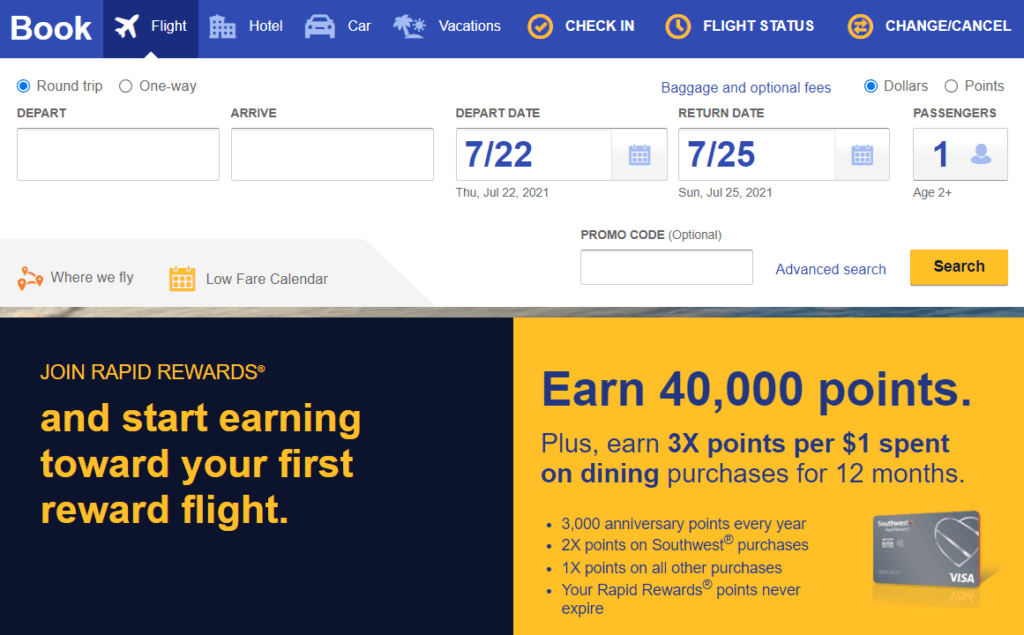
The global tourism industry should grow at a CAGR of 4% over the next five years. The growth rate is higher in the US and remains at 5%. This high growth trend in the global tourism industry enhances the business of the company. Southwest Airlines can position itself as the desired carrier for tourists and use this to increase the number of people traveling with them.
A while back, Southwest Airlines expanded its local flights to Hawaii. The improved financial situation and globalization should prompt the airline to expand further since air travel increases in emerging economies. South America has an unsaturated market, which is a great stepping stone for the global expansion of Southwest Airlines.
Millennials are taking up job opportunities, and most of them live further from home than preceding generations. This leads to a demand for lengthier flights. To exploit its growing demand, Southwest Airlines can expand from short hauls to long flights.
Ultra-Low-Cost airline routes are gaining popularity day by day. Ultra-Low-Cost Carriers unbundle the fare. They break down the full fare into components. Passengers can choose to eliminate any of the components. Anything beyond the base fare is optional.
Southwest offers low fares and is a low-cost carrier. However, it is not an ultra-low-cost carrier. Exploring opportunities in the ULCC niche will help Southwest breakthrough.
The airline industry has to satisfy many economic and operational regulatory bodies like the DOT and FAA. Also, the company has to comply with many health, operational, and safety regulations. The emergence of online e-commerce means that the company has to address data privacy and informational technology regulations. All these regulations can put this airline at a hard place trying to satisfy them, limiting growth.
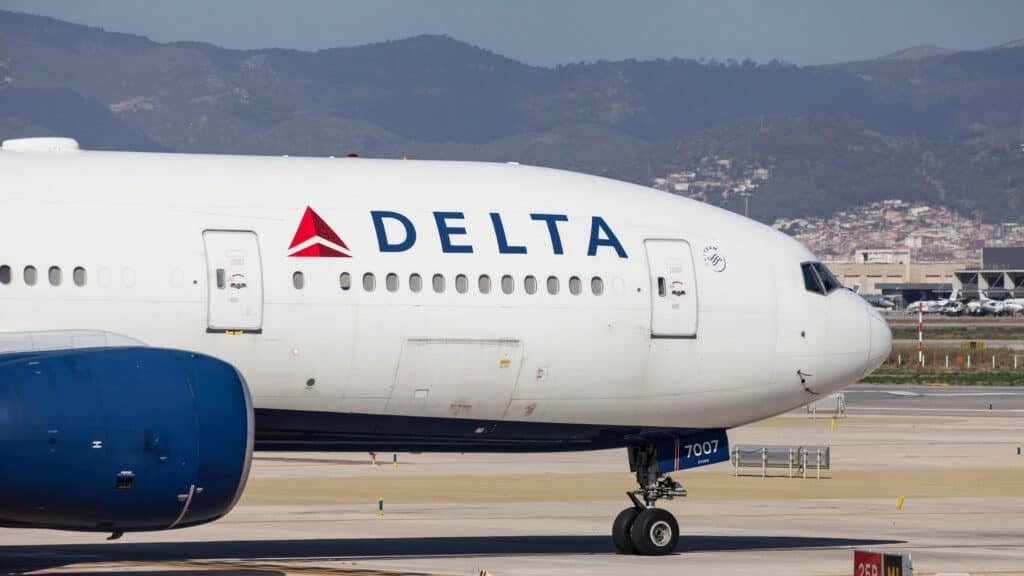
There are many players in the US airline industry competing with Southwest Airlines. Some of these companies are Alaska, United, Spirit, American, Delta, and Jet Blue. The players in the airline industry are not the only ones competing with Southwest Airlines. They also face competition from trains, buses, and automobiles.
In an economic turndown, customers forego using flights and opt for less expensive transportation modes.
The US Government revealed that Southwest Airlines had been flying jets without confirming the maintenance records for more than two years. This exposed more than 17 million passengers to safety risks. Such bad publicity can keep customers from traveling with this airline as they opt for the competition.
Answer: Yes. If you are affected by any involuntary change, you can change your flight time by up to 14 days from the original day of travel at no extra cost. Sometimes, Southwest Airlines can change their flights’ schedule, and if your flight is affected, they will email or call you with a new itinerary. If the new trip does not work for you, you can cancel or change it.
You will not be required to pay any fee if you change your flight. But, if there will be a difference in the fare of the new flight, you will have to pay. Likewise, if the new flight costs less, Southwest will refund the difference or hold the difference for future use in the form of a reusable travel fund.
Answer: Southwest has two cancellation policies . You can decide if you want to hold the value of the ticket where it will be converted to a travel fund which you can use to buy a future flight. Alternatively, you can choose to receive a method of payment refund.
Answer: A carry-on bag should be 10 x 16 x 24 inches. If your bag is bigger than these dimensions, you should check it at the ticket counter. If it is larger than the dimensions, you will have to pick it at the baggage claim. Carry-on items are limited to one small bag, a big one, and a personal item. The personal items have to fit in the space under the seat, which is 18.5 x 8.5 x 13.5 inches.
Answer: Travel funds are a credit form of cancelled flights that can be used to buy future flights. The funds are tied to the six-digit confirmation number on the cancelled flight. The travel fund expires on the date the original ticket will expire.
Southwest Airlines is the leading domestic carrier in the US market. For faster growth, the company should invest in international expansion. It will also benefit significantly from forming joint ventures with other successful airlines. Southwest Airlines has major opportunities that will help it gain more profitable growth.
Recommended Reads:
- Southwest Business History
- Southwest Airlines Competitors Analysis
- Home Depot Business History
- Sundar Pichai Bio: All You Need to Know About Google’s CEO
- Home Depot SWOT Analysis
- FedEx Mission Statement Explained : What is FedEx’s Philosophy?
- Latest Posts

- Dan Bilzerian Bio - December 9, 2022
- OLA Model Explained - November 23, 2022
- Service Value Chain Explained - November 23, 2022
Leave a Comment Cancel Reply
Your email address will not be published. Required fields are marked *
Save my name, email, and website in this browser for the next time I comment.

- Calculators
- Swot Analysis
- Pestle Analysis
- Five Forces Analysis
- Organizational Structure
- Copywriting
- Research Topics
- Student Resources
Services We Provide

Resources We Provide

Login / Register

- A Scrupulously Conducted SWOT Analysis of Southwest Airlines
- Southwest Airlines Overview
Southwest Airlines is a highly renowned American airline that serves more than 47 states within the US and also offers international flights to more than 10 countries. The airline was founded in 1967 and is headquartered in Dallas, Texas in the United States. With a market share of around 17 percent in the US airline industry, Southwest Airlines is one of the most successful airline companies in the United States.
This article presents a fastidious and well-researched SWOT Analysis of Southwest Airlines looking into the comparisons between the strengths and weaknesses of the company. Furthermore, the analysis highlights the different opportunities and threats for Southwest Airlines in the external business environment. In case you wish to learn about conducting a SWOT analysis in detail, you should definitely go through our meticulous Swot Analysis guide . So, let us get started.
Table of Contents
- Southwest Airlines Strengths
- Southwest Airlines Weaknesses
- Opportunities for Southwest Airlines
- Threats for Southwest Airlines
A meticulous SWOT Analysis of Southwest Airlines

Southwest Airlines’s strengths
- Strong financials- Southwest Airlines has abundant financial resources with its revenue in 2021 increasing by a huge margin of 74.5% to $15.8 billion. Further, the company had net cash of $4.8 billion which can help it overcome negative situations and exploit new opportunities (Southwest 2022).
- Brand value- Southwest Airlines is valued highly in the US market. The company has featured 22 times in various rankings including the strongest and most valuable US brands , the biggest Airlines brands, and the best global brands. It is currently the 4th most valuable airlines brand and is valued at $6.8 billion.
- Strong market share- Southwest Airlines has a strong foothold in the US market with a 17.4% market share (Salas, 2022).
- Customer service- Southwest Airlines provides various facilities to enhance customer satisfaction. These include Early Bird Check-In, wherein the customers can check-in through the web and are assigned boarding passes prior to commencement of regular boarding. Further, most of the planes have inflight entertainment and Wi-Fi services on the majority of their fleet.
Southwest Airlines’s weaknesses
- Limited routes- Southwest Airlines operates to limited destinations that include the US, 4 destinations of Mexico, and Puerto Rico along with Bahamas, Cuba, and a couple of other Caribbean destinations.
- Over-dependence on Boeing 737- The whole fleet of Southwest Airlines comprises of Boeing 737 out of which 69 are the Max 737 and further the delivery is pending for 234 Max 737’s and 149 Max 8 (Josephs, 2021). Governments all around the world banned Max 737s for about two years due to safety issues. The over-dependence of the company on Max 737 can cause disruption in the operations.
Southwest Airlines’s opportunities
- Expansion to more countries- Currently Southwest Airlines flies in 47 US states along with Mexico and a few Latin American countries. The company can expand its operations in emerging economies like India and China. Indian aviation has grown tremendously over the years and would be the third-largest aviation market by 2024. Further, China is also witnessing high growth and it is expected that China’s fleet size would rise to close to 10,000 planes by 2040, almost 22% of the world’s fleet, thus highlighting huge growth opportunities.
- More investment in cargo shipment- The revenues from the freight operations constitute just 1% of the total sales (Forbes, 2020). The company can enhance its cargo operations by tying up with several cargo operators that would enable it to penetrate more into the markets. Furthermore, Southwest airlines can also tie-up with US Postal Services to deliver the packages to the customers.
- Integration of latest technology- Southwest Airlines can use the latest technologies like robotics for conducting ground operations and can tie up with wearable tech companies to provide facilities for storing boarding passes on the device and providing them real-time information on the devices themselves. This would ease the passenger experience.
Southwest Airlines’s threats
- Competition- Southwest Airlines has intense competition with Delta Airlines, and American Airlines among others. American Airlines is the top airline in the US market with a 19.5% market share and has a fleet of 860 planes. Delta Airlines is also a significant player with a 16.3% market share, 860 aircraft and it earned a profit of $280 million in 2021 (Josephs, 2022).
- Increase in crude prices- The prices of crude have risen by more than 70% in the last 12 months to $113/barrel. Further, the US government’s decision to cease oil imports from Russia could add to Southwest Airlines’ worries as the prices would rise further and there can be disruptions in supply as well which could impact the financials of the company.
- Negative publicity- The company flew its airplanes for two years by violating the federal aviation administration’s laws wherein it didn’t possess any records for maintenance (Slotnick, 2020). This type of behavior can result in fatal accidents and loss of trust among the passengers.
- Pandemic- The increase in the intensity of the virus can pose a threat to the business of the company as it would have to ground the planes, which would result in huge financial loss to the company.
- Variation in demand for travel- Most of the revenues are generated during the summer months when the demand for air travel is at its peak while the demand is low in the first and third quarters of the calendar year.
To conclude, it can be said that Southwest Airlines is one of the best and most trustworthy in the industry which is evident from the fact that in spite of difficult times because of COVID, Southwest Airlines has been able to maintain positive financial growth and its customer service is one of the best in the industry despite it being the low-cost carrier with the limited operations. This showcases the company’s dedication to its customers and other stakeholders. However, the governments worldwide are not satisfied with the operations of the Boeing 737 because of its failure on various occasions, and the company’s over-dependence on the 737 can lead to disruption in the operations if the governments gain plan to ban the fleet. Also, you can read the PESTLE Analysis of Southwest Airlines to determine how the macroenvironment factors influence the company or the automotive industry.
Recommended Readings
SWOT Analysis of Ryanair
SWOT Analysis of British Airways
SWOT Analysis of Boeing
SLOTNICK, D. (2020). Southwest flew millions of passengers on planes that were missing maintenance records, according to a new report. Retrieved 11 April 2022, from https://www.businessinsider.in/business/news/southwest-flew-millions-of-passengers-on-planes-that-were-missing-maintenance-records-according-to-a-new-report/articleshow/73813012.cms
Gilbertson, D. (2020). 'Diversion, distraction and power': Audit blasts Southwest's safety culture, FAA oversight. Retrieved 11 April 2022, from https://www.usatoday.com/story/travel/airline-news/2020/02/11/southwest-airlines-audit-blasts-safety-culture-faa-oversight/4729635002/
Global Times. (2021). COMAC predicts China to become world's largest aviation market by 2040. Retrieved 11 April 2022, from https://www.globaltimes.cn/page/202109/1235463.shtml
Josephs, L. (2021). Southwest Airlines raises order for smallest Boeing 737 Max by 34 planes. Retrieved 11 April 2022, from https://www.cnbc.com/2021/06/08/southwest-orders-34-more-of-boeings-smallest-737-max-plane.html#:~:text=The%20Dallas%2Dbased%20airline%20said,the%20company%20retires%20older%20737s.
Walther, B. (2021). Spotlight on North America: Top 10 Biggest American Airlines By Fleet Size. Retrieved 11 April 2022, from https://www.id1.de/2021/07/07/spotlight-on-north-america-top-10-biggest-american-airlines-by-fleet-size/
Sign up for our Newsletters
Enter your email address to register to our newsletter subscription delivered on a regular basis!
Copyright © 2023 CrowJack. All Rights Reserved

A unique take on Southwest Airlines Strategy
Anyone who has studied business management either as a degree or as an elective would have definitely studied Michael Porter’s 5 Forces framework. This framework was first published in Harvard Business Review in 1979. The model is very much relevant in 21st-century business as well due to its deep 360-degree view of a business.
One of the 5 forces is called “Barriers to Entry” and more often than not either Oil & Gas or Airline industry would serve as an apt example of an industry with very high barriers to entry due to its high Capex and Opex requirements.
But wait, then with so many barriers to entry, why do airlines still bleed red? There are many reasons for this, but one of them is stiff competition with low-cost carriers, the 5th, and the framework’s central force (competition among the players).
Before we move on, the below is an interesting tweet response from Anand Mahindra, on being asked to buy the ailing “ Jet Airways ”.
Remember the quote: “If you want to be a millionaire, start with a Billion dollars and then start (buy) an airline!” https://t.co/dYRdwup3kK — anand mahindra (@anandmahindra) June 29, 2019
The US Airline Industry
Following the 9/11 attacks, the US airline industry has been through rough weather. 20+ airlines have filed for bankruptcy protection under Chapter 7. 60+ airlines have filed for bankruptcy protection under Chapter 11. This list also includes the top 3 out of 4 airlines namely, American Airlines, United & Delta Air Lines, however they were able to exit the bankruptcy within a few years.
The landscape has been constantly changing with a high volume of mergers and acquisitions, resulting in changing market share statistics.
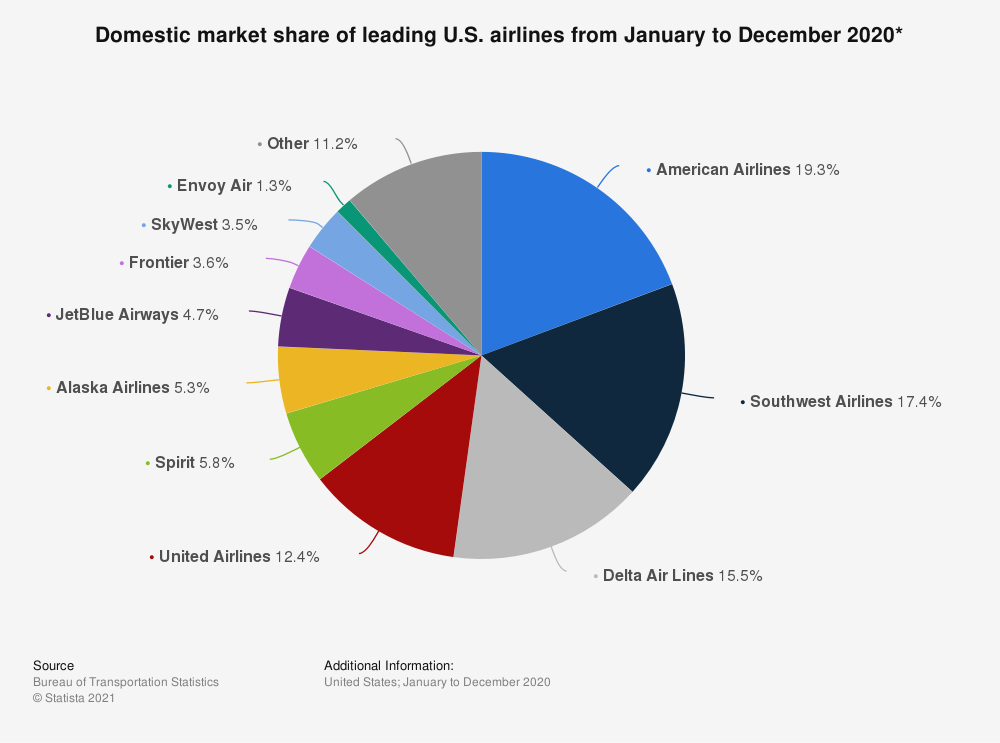
The graph above covering the period January to December 2020 showcases that the top 4 airlines constitute approx. 65% of the market share.
In this story, we are focusing on Southwest Airlines that was founded on the notions of the low-cost carrier but with its unique strategy has been profitable for the last 45 years in a row.
The takeoff strategy of Southwest Airlines
Southwest Airlines Co. , typically referred to as Southwest, is one of the United States’ major airlines and the world’s largest low-cost carrier airline. The airline was established on March 15, 1967, by Herb Kelleher as Air Southwest Co. and adopted its current name, Southwest Airlines Co., in 1971, when it began operating as an intrastate airline wholly within the state of Texas first flying between Dallas, Houston and San Antonio.
Most airlines back in the 1960s followed the most popular “Hub and Spoke” model for their operations.
Hub and Spoke model – As the name suggests, there is a defined hub from where the flights originate, and the destinations are the spokes.
The benefit of a hub and spoke model is that it has fewer routes, but the major drawback of this model is its rigidity, and if there is a slight change in the airline routing due to weather, etc., it can have cascading consequences to the other planned flights.

Point to Point model – Southwest, being a low-cost carrier, focused more on the point to point model and bought significant process improvements, in a way mastered it to achieve very high operational efficiency.
In the point-to-point model, each flight is a single journey. The origin and destination are connected via a single non-stop flight. The point-to-point model offers more travel options and flexibility as compared to the hub and spoke model.
For passengers undertaking further journeys, they will have to collect the baggage and recheck them for leg 2 of their journey. This model has considerably led to saved travel hours and done away with the necessity for connecting flights.

Key Differentiating Factors in Southwest Airlines Strategy
Southwest airlines is the third largest airline in the United States of America and arguably the biggest in the low-cost carrier segment across the globe.
So, was the operational efficiency gained due to the change in the flight operations model the only reason why Southwest airlines is the #1 low-cost carrier in the world?
NO, let’s understand what differentiated Southwest airlines strategy from its counterparts.
Customer Eccentricity
For Southwest, they keep the customers at the center of their business operations. They offer certain benefits to flyers which are not offered by other airlines, like
- Southwest allows two checked-in bags, free of cost, unlike many of its competitors.
- Flight change thirty minutes prior to the departure is allowed by Southwest.
- Southwest offers free in-flight entertainment like Live TV, Movies, use of whatsapp and imessage. It offers Wi-Fi services at very nominal rates.
All these have resulted in Southwest being the airline with the least number of complaints, according to the Department of Transportation of the United States of America.
Only one type of aircraft
Many airlines have different types of aircraft in their fleet, but not Southwest. Southwest operates by using only Boeing 737 aircraft. It saves a lot of money by:
- Training cabin crews and support staff on only one type of aircraft.
- Maintenance of inventory of spare parts for one aircraft type.
- In case of breakdown, alternate aircraft can be arranged immediately.
- Its policy of not assigning seats helps tremendously as customers can take any available seat when boarding the aircraft, thereby reducing the boarding time. In the case of alternate aircraft also, this policy hugely benefits the airline reducing the turnaround time.
Right recruitment policies
Southwest stresses a lot on the customer experience and hence it is very imperative for the airline to hire the right kind of people. Southwest focusses on hiring people who have an attitude for serving customers.
Employees undergo various pieces of training which also includes cross-training. Training is heavily centered around team building and collaboration.
The Southwest Airlines case study is a lesson in cultural strategy. An organization built on the fundamentals of customer eccentricity, effective processes, and a dedicated team is meant to achieve success and overcome challenges. This model of exceptional customer service can help a business earn an impeccable reputation in the industry. That’s what makes the Southwest model uniquely priced, yet one profitable in this cruel airline industry.
Southwest’s ability to be different and not follow the herd—not to mention becoming America’s largest airline—can be traced in large part to the Airline Deregulation Act. Thanks to this act, Herb and Rollin realized their Vision and the traveling public benefits on every flight, every day. Gary Kelly, Chairman & CEO, Southwest Airlines
-AMAZONPOLLY-ONLYWORDS-START-
Also, check out our most loved stories below

Johnnie Walker – The legend that keeps walking!
Johnnie Walker is a 200 years old brand but it is still going strong with its marketing strategies and bold attitude to challenge the conventional norms.

Starbucks prices products on value not cost. Why?
In value-based pricing, products are price based on the perceived value instead of cost. Starbucks has mastered the art of value-based pricing. How?

Nike doesn’t sell shoes. It sells an idea!!
Nike has built one of the most powerful brands in the world through its benefit based marketing strategy. What is this strategy and how Nike has used it?

Domino’s is not a pizza delivery company. What is it then?
How one step towards digital transformation completely changed the brand perception of Domino’s from a pizza delivery company to a technology company?

BlackRock, the story of the world’s largest shadow bank
BlackRock has $7.9 trillion worth of Asset Under Management which is equal to 91 sovereign wealth funds managed. What made it unknown but a massive banker?

Why does Tesla’s Zero Dollar Budget Marketing Strategy work?
Touted as the most valuable car company in the world, Tesla firmly sticks to its zero dollar marketing. Then what is Tesla’s marketing strategy?

The Nokia Saga – Rise, Fall and Return
Nokia is a perfect case study of a business that once invincible but failed to maintain leadership as it did not innovate as fast as its competitors did!

Yahoo! The story of strategic mistakes
Yahoo’s story or case study is full of strategic mistakes. From wrong to missed acquisitions, wrong CEOs, the list is endless. No matter how great the product was!!

Apple – A Unique Take on Social Media Strategy
Apple’s social media strategy is extremely unusual. In this piece, we connect Apple’s unique and successful take on social media to its core values.
-AMAZONPOLLY-ONLYWORDS-END-

Vinit Joshi is Corporate Planning & Strategy professional with 15+ years of experience across renowned & diversified business groups. When not working or spending time with family, Vinit loves listening to a variety of music
Related Posts

AI is Shattering the Chains of Traditional Procurement

Revolutionizing Supply Chain Planning with AI: The Future Unleashed

Is AI the death knell for traditional supply chain management?

Merchant-focused Business & Growth Strategy of Shopify

Business, Growth & Acquisition Strategy of Salesforce

Hybrid Business Strategy of IBM

Strategy Ingredients that make Natural Ice Cream a King

Investing in Consumer Staples: Profiting from Caution

Storytelling: The best strategy for brands

How Acquisitions Drive the Business Strategy of New York Times

Rely on Annual Planning at Your Peril

How does Vinted make money by selling Pre-Owned clothes?

N26 Business Model: Changing banking for the better

Sprinklr Business Model: Managing Unified Customer Experience

How does OpenTable make money | Business model

How does Paytm make money | Business Model
Write a comment cancel reply.
Save my name, email, and website in this browser for the next time I comment.
- Advanced Strategies
- Brand Marketing
- Digital Marketing
- Luxury Business
- Startup Strategies
- 1 Minute Strategy Stories
- Business Or Revenue Model
- Forward Thinking Strategies
- Infographics
- Publish & Promote Your Article
- Write Article
- Testimonials
- TSS Programs
- Fight Against Covid
- Privacy Policy
- Terms and condition
- Refund/Cancellation Policy
- Master Sessions
- Live Courses
- Playbook & Guides
Type above and press Enter to search. Press Esc to cancel.
Southwest Airlines: Point-To-Point Business Strategy Case Study
A short description about the southwest airlines, main issues/problems of the case, situational analysis, answering the questions.
Southwest Airlines (initially known as Air Southwest) launched its first flight in 1971. Its founders were Herb Kelleher and Rollin King. By then, the company only served three cities within US (Houston, San Antonio, and Dallas) and had not expanded its operations beyond the country. Unfortunately, it incurred remarkable losses in the first two years of its operation. This forced it to vend one of its four aircrafts instead of sacking some of its employees.
After enacting viable business strategies, Southwest Airline managed to overcome such obstacles. It announced its first profits in 1973. By 1977, the company had expanded its operations. It served other additional cities like El Paso, Lubbock, and Corpus Christi among others. It later launched interstate destinations within US indicating its prospective growth.
Later in 1986, the firm established a training program to equip its flight crews with viable business etiquettes. This enabled it to enhance its competitiveness in the realms of customer services. It later won a monthly Triple Crown prize due to its exemplary services. Upon its rapid expansion, the company acquired Moris Air in 1994 and consequently enhanced its flights to other cities within US.
It introduced Ticketless Travel in various cities, a move that augmented its business’ prowess. As at 2006, Southwest Airlines had advanced both technologically, revenue acquisition, and business wise. It acquired ATA Airlines allowing it to attain boarding slots in LaGuardia Airport, New York. This move enabled it to handle international flights after partnering with WestJet Airlines (a prominent low-cost carrier).
The company had to increase its charges for both domestic and international services in order to survive in the industry. In order to overcome current challenges facing the airline industry, Southwest Airlines has embraced technological innovations, price adjustments, protocol reforms, and viable acquisitions and mergers.
Southwest Airlines is facing numerous problems within the aviation industry. Firstly, there is a constant increase in fuel prices. This leads to increased business costs and other relevant challenges engulfing the entire industry. Another problem is the increase in operational costs mentioned earlier. An airline business is costly to establish, ratify, and operate due to massive logistical issues involved in the entire context.
Southwest Airlines is also experiencing such problems despite the witnessed success. There is a considerable need to reduce costs and increase profits in numerous occasions. It is from this context that the entire problems facing the industry lie. Additionally, it is important to consider that some airline business slump due to higher operational costs and reduced profits. Another problem is the current security threats that face the company and other players in the airline industry.
Such security problems might force the company to cancel some of its flights leading to reduced revenues and consequent losses. The global economic crisis has equally contributed to the mentioned problems. Economic catastrophe affects market trends, travelling schedules, and reduces the influx of customers since most organizations and individuals strive to minimize expenditures. Fluctuating fuel prices is another problem facing the company due to unpredictability of fuel costs mentioned earlier.
The company is equally unsure whether its point-to-point business strategy will apply as it tries to expand its domestic operations. Another problem is the stringent competition within the industry. International expansion strategies, union walkouts, and environmental uncertainties are some of the problems faced by the organization.
SWOT analysis, PEST analysis, & internal analysis (strengths & weaknesses)
When subjected to SWOT analysis, Southwest Airlines has numerous strengths in its business endeavors. The company has several competitive advantages compared to its rivals in the aviation industry. Additionally, it has established right products for its clients. This is evident in the travel arrangements, reliability, and variability in the destinations it covers. Additionally, it embraces technology and innovation to ensure that it remains competitive.
Concurrently, the company has trained competent human capitals hence capable of achieving customer satisfaction. Southwest Airlines has equally enhanced its customer services and changed business processes in order to attain the desired competitiveness. Conversely, the company possesses some weaknesses when analyzed critically.
Some of its customer services still need to meet international standards. The aspects of technology have not been fully enacted in the company despite the stringent competitions experienced. Additionally, it has limited international flights compared to other prominent competitors in the very industry.
Southwest Airlines has numerous opportunities it can cease in order to enhance its competitiveness, revenues, and customer value when scrutinized critically. The demand for aviation services is rapidly growing despite the recent economic challenges. This indicates that the company might perform well in future due to increased flight demands. Another opportunity is the merger it makes with other international airlines like WestJet Airlines. Additionally, the fact that it has a competent, innovative, and creative workforce is crucial.
This provides another considerable opportunity in the entire scenario. There are various opportunities in the aviation industry, which the company can harness in order to remain competitive in the market. Conversely, there are business threats that might hinder the wellbeing of Southwest Airlines. The fluctuating fuel prices, global fiscal crisis, stringent competition, security threats, high operational costs, and adverse international regulations form critical threats to the company.
There are also some issues that emerge when Southwest Airlines is subjected to PEST analysis. Political issues can affect the company massively. This is possible with regard to political trends, legislations, international policies, political wrangles, and other prominent business aspects in the entire scenario.
Economic factors incorporate the current global financial challenges and other considerable factors. Additionally, there are other specific economic factors in the aviation industry that have affected Southwest Airlines. This incorporates high operational costs within the industry, fluctuating fuel costs, and other potential fiscal problems facing the industry.
On social factors, the company enjoys changing lifestyles that have promoted the use of aircrafts as a means of travelling and sending important cargos. The use of flights is embraced by people of different ages. Additionally, the company has embraced technology in its various operations. Southwest Airlines has been innovative in its business approaches, a fact aided by technological advancements within the business.
Value Chain Analysis
Southwest Airlines has attained considerable competitive advantages in the business realms having enacted and embraced stringent and viable value chains in its endeavors. Airline industry is quite competitive hence demanding its players to embrace considerable value chain provisions as evident in the provided case. The entire business activities that Southwest Airlines assumes in its daily operations have contributed to the aspects of the alleged value chain.
Things done in every department or sectors of the company contribute to the demanded value chain. This is quite important in various aspects. The management of the company, employees, suppliers, affiliates, and other considerable stakeholders have endeavored to add value to the service provision granted by the company.
The ultimate competitive advantages noticeable within the company result from considerable contributions made by the entire stakeholders. It is from this observation that Southwest Airlines attains its ultimate value chain. This has enabled it to grow tremendously in the past years despite the challenges.
Customers have also trusted the services given by the company as evident in the case. Due to these provisions, the company has managed to grasp a considerable market share as evident by its continuous business growth. Additionally, the use of appropriate business approaches and staying customer-focused has allowed the business to augment its competitiveness in the airline industry despite the noticeable challenges.
Industry (Porter’s 5 forces analysis)
Porter’s 5 forces are applicable in the airline industry with respects to the provided Southwest Airlines’ case. This is an important observation following its relevancy in the entire context. For example, threat from new entrants into the industry is applicable in this context. Southwest Airlines and other existing airline firms are threatened by the entrance of other competitive rivals. However, since the industry is costly to establish and operate, such chances are limited.
Additionally, there is a considerable rivalry from the existing firms within the American market and beyond. Other international airlines like Emirates Airlines and Qatar Airlines among others have fronted stringent competition to Southwest Airlines with regard to its international markets. Additionally, the bargaining power of buyers is evident in the industry due to competition. Customers go for cheap and reliable airline companies.
This has forced other industry players to strategize properly and cut prices. Additionally, suppliers operating in the industry have equally fronted their bargaining power. The jet fuel suppliers usually change the cost of fuels to suit their business interests. This is a massive challenge to the industry and beyond.
Another apparent force evident in the case is the availability of substitute products/services. Airline customers can seek the services of other companies if such needs arise. This factor forces numerous businesses to establish their competitive advantages and other relevant business strategies.
Southwest Airlines experience competition from various firms. This occurs both locally and internationally. Since the company started as local airline business, all the local airlines in US as at then provided considerable competition provisions. On the international flights, Southwest Airlines experiences competition from well-established airline companies globally.
Evidently, Southwest Airlines can still maintain 36-year streak profitability despite the challenges mentioned in the case. This is possible since the industry is growing rapidly while the company has numerous strengths and opportunities to cease this opportunity. Additionally, the company can still depend on fuel hedging to control cost despite the fluctuating oil prices. This is possible through proper management and other characterizing factors.
Concurrently, the point-to-point methodology will still be useful as the company enhances its domestic flights. This is possible since it adds massive competitive advantages to the company against other rivals. Major traditional airlines will threaten Southwest Airlines when they become low-cost counterparts.
Additionally, the company will be able to expand internationally, maintain its positive relations with employees, and avoid future union walkouts and bargains. Despite the probable persistence of the current financial crisis, Southwest Airlines will still expand if it enacts its business strategies evident in the case. The company can embrace viable business strategies to curb environmental uncertainties. This will help it maintain its loyalty to customers.
- Chicago (A-D)
- Chicago (N-B)
IvyPanda. (2019, May 19). Southwest Airlines: Point-To-Point Business Strategy. https://ivypanda.com/essays/southwest-airlines-analysis-case-study/
"Southwest Airlines: Point-To-Point Business Strategy." IvyPanda , 19 May 2019, ivypanda.com/essays/southwest-airlines-analysis-case-study/.
IvyPanda . (2019) 'Southwest Airlines: Point-To-Point Business Strategy'. 19 May.
IvyPanda . 2019. "Southwest Airlines: Point-To-Point Business Strategy." May 19, 2019. https://ivypanda.com/essays/southwest-airlines-analysis-case-study/.
1. IvyPanda . "Southwest Airlines: Point-To-Point Business Strategy." May 19, 2019. https://ivypanda.com/essays/southwest-airlines-analysis-case-study/.
Bibliography
IvyPanda . "Southwest Airlines: Point-To-Point Business Strategy." May 19, 2019. https://ivypanda.com/essays/southwest-airlines-analysis-case-study/.
- Success Behind the Southwest Airlines Co.
- An Analysis of Southwest Airlines
- Southwest Airlines: Corporate Culture Review
- Joint Ventures in India: Strategic Analysis
- JCB in India
- Toyota Motor Manufacturing
- Overview of Costco Company
- Enron Corp. Business Environment and Strategic Position

- About / Contact
- Privacy Policy
- Alphabetical List of Companies
- Business Analysis Topics
Southwest Airlines’ Generic Competitive Strategy, Growth Strategies
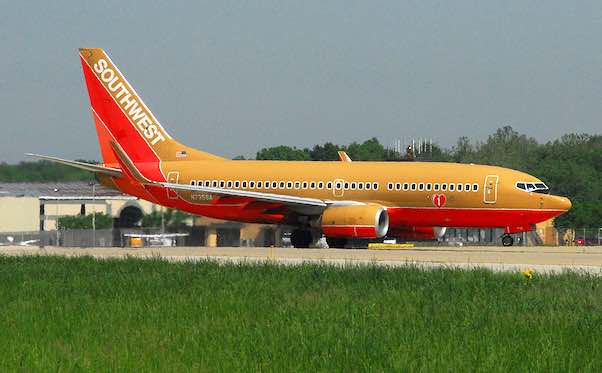
Southwest Airlines’ generic competitive strategy (Porter’s model) ensures product/service attractiveness and competitive advantages for successfully implementing intensive strategies for growth (Ansoff Matrix). With a strategic position as one of the main competitors in the commercial aviation industry in the United States, the company is popular for its low fares and high accessibility. These variables relate to Southwest’s intensive growth strategies and generic competitive strategy. In Michael E. Porter’s model, competitive advantage is developed through generic competitive strategies that the airline company can apply. On the other hand, based on Igor Ansoff’s matrix, Southwest Airlines can use various intensive growth strategies. These corporate strategy frameworks are considered in this business analysis of the commercial aviation company and its approach to growing despite strong competitors. Southwest’s success indicates effective implementation of its generic strategy for competitive advantage and intensive growth strategies suited to the business.
Southwest Airlines uses its generic competitive strategy to counteract the competitive power of other firms, such as Delta Air Lines, United Airlines, and American Airlines. These competing commercial aviation companies possess resources and the operating scale to grow despite the competitive landscape. Southwest’s intensive growth strategies facilitate the operational scale needed to maintain the corporation’s generic strategy, thereby also strengthening its competitive advantage and competitive positioning in the industry.
Southwest’s Generic Competitive Strategy (Porter’s Model)
Southwest Airlines’ generic competitive strategy is cost leadership , which creates competitive advantage based on low costs and correspondingly low prices. To address competition, the company’s strategic objective in this generic competitive strategy is to minimize operating costs, optimize profit margins, keep low prices, and offer its airline services to the mass market. The large-scale operations linked to this generic strategy for competitive advantage supports the fulfillment of Southwest Airlines’ mission statement and vision statement , which aim for global leadership in the industry. The commercial aviation corporation’s success depends on effectiveness in implementing the generic competitive strategy of cost leadership.
Cost leadership as a generic competitive strategy is observable in Southwest Airlines’ service offerings as a low-cost carrier. The company’s advertising campaigns frequently emphasize low fares as a selling point, in contrast to other firms that use the focus strategy or the differentiation strategy, such as Delta. In a way, Southwest has a best-cost provider strategy, as the company continues to minimize costs while also maintaining a high level of customer satisfaction through service quality. Based on its generic competitive strategy, the enterprise presents itself as a major commercial aviation contender in terms of price and in terms of warmth and friendliness in its customer service.
Southwest’s Intensive Growth Strategies (Ansoff Matrix)
Market Penetration . With its generic competitive strategy, Southwest Airlines applies market penetration as its primary intensive growth strategy. The company’s strategic objective in this intensive strategy is to grow its revenues by providing more of its current air transportation services to more passengers in markets where it currently operates. Southwest’s generic strategy of cost leadership ensures low costs that translate to across-the-board low prices that are a competitive advantage for keeping a large share of the commercial aviation market, in support of market penetration as an intensive growth strategy. The price sensitivity of customers in the transportation sector is one of the factors that make cost leadership and market penetration effective strategies in this case. The business strengths and competitive advantages identified in the SWOT analysis of Southwest Airlines Co. attract customers and support the success of market penetration. The strong airline brand and attractive prices enable this intensive growth strategy. Also, Southwest Airlines’ marketing mix (4P) determines how the company penetrates the target market.
Product Development . Product development is a minor intensive growth strategy in Southwest’s organizational development. The corporation’s competitive advantage depends mainly on cost leadership as its generic competitive strategy, and market penetration as its intensive strategy for airline business growth. Southwest’s product evolution has already stabilized, which means that the business has been aiming its product development efforts mostly at enhancing its current offerings. Thus, product development, as an intensive growth strategy, minimally contributes to growing the airline company. Changes in current products require corresponding changes in Southwest Airlines’ operations management, which manifests the applied intensive growth strategies and generic competitive strategy for competitive advantage in commercial aviation. The organizational culture (corporate culture) of Southwest Airlines is also a factor integrated into product development, as the company relies on organizational cultural variables to optimize its service quality and customer satisfaction and loyalty.
Market Development . The growth of Southwest Airlines minimally depends on market development. This intensive growth strategy aims to offer current services to new commercial aviation markets. When applying market development, the generic competitive strategy of cost leadership ensures competitive advantage in new civil aviation markets. However, Southwest continues to focus on its limited multinational operations in the United States and a few other countries. Thus, market development is not a significant intensive growth strategy for the airline business.
Diversification . Diversification is an insignificant intensive growth strategy for Southwest Airlines. The objective of this intensive strategy is to grow the company through new operations, such as service businesses related to air travel operations. Southwest focuses on growing within its current markets, with minimal emphasis on using the generic competitive strategy of cost leadership for competitive advantage in diversifying its business. Thus, diversification is an insignificant intensive growth strategy in the airline business. The addition or expansion of business operations requires accompanying changes in Southwest Airlines’ organizational structure (business structure) .
Key Points – Southwest’s Generic Competitive Strategy & Intensive Growth Strategies
Southwest Airlines applies cost leadership as its generic strategy for competitive advantage, along with intensive growth strategies to maximize market share and move toward its long-term goal and strategic plan of becoming a global industry leader. The intensive strategy of market penetration provides support for the airline company’s generic competitive strategy of cost leadership, and vice versa. Southwest’s brand image and service quality reflect these strategies and associated competitive advantages. For example, customers know the company for low airfares, which are a consequence of cost leadership as a generic competitive strategy that leads to cost-based and price-based competitive advantages. Also, Southwest is known for its large-scale operations, which are a result of market penetration as an intensive growth strategy.
- Kerkemezos, Y., Pennings, E., Karreman, B., & van Reeven, P. (2023). Price asymmetries and the path dependence of market power: Evidence from the US airline industry. International Journal of Industrial Organization, 87 , 102921.
- Liang, X., Luo, Y., Shao, X., & Shi, X. (2022). Managing complementors in innovation ecosystems: A typology for generic strategies. Industrial Management & Data Systems, 122 (9), 2072-2090.
- Southwest Airlines Co. – Form 10-K .
- Southwest Airlines Co. – Proven Business Strategy .
- U.S. Department of Commerce – International Trade Administration – Travel, Tourism & Hospitality Industry .
- Copyright by Panmore Institute - All rights reserved.
- This article may not be reproduced, distributed, or mirrored without written permission from Panmore Institute and its author/s.
- Educators, Researchers, and Students: You are permitted to quote or paraphrase parts of this article (not the entire article) for educational or research purposes, as long as the article is properly cited and referenced together with its URL/link.
Southwest Airlines SWOT Analysis
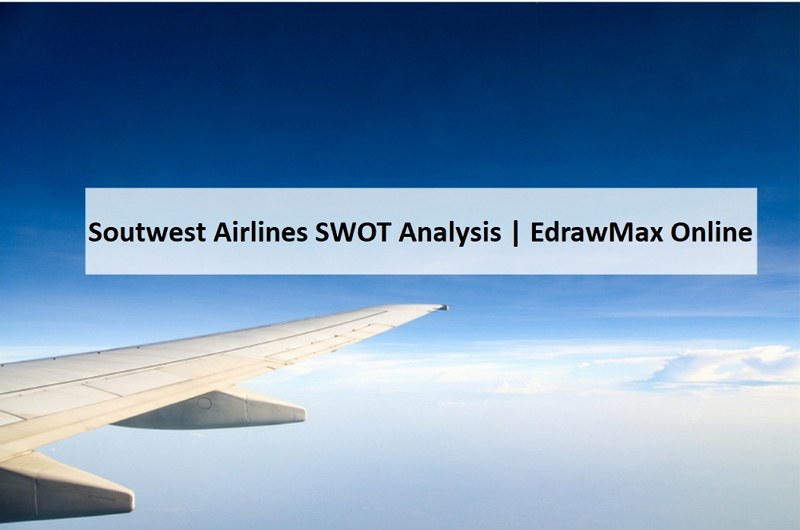
1. Background of Southwest Airlines
1.1. general overview of southwest airlines, 1.2. introduction to southwest airlines.
For the SWOT analysis Southwest Airlines , it is crucial to know about its past and future planning. Southwest Airlines is one of the major airlines of the U.S.A. It is also famous as the world's largest low-cost carrier airline. It schedules services to 111 destinations not only in the U.S.A. but also in ten additional countries. The company began operating as an intrastate airline in Texas, Dallas, San Antonio, and Houston in 1971.
At present, the company has 60,000 employees, and it operates nearly 4000 departures a day during its peak season. As per the records of 2018, Southwest airlines carried a maximum number of domestic passengers.
1.3. Development Timeline of Southwest Airlines
2. swot analysis of southwest airlines.
The Southwest Airlines SWOT analysis can find out the strategies that can help the company to strengthen its position and maximize revenue. It identifies the effects of competition and weaknesses as per the culture and organizational structure. The company can work on business diversification to gain stability in the market.
2.1. SWOT Analysis of Southwest Airlines in Detail
In SWOT analysis, 'S' actually stands for strength. It is always essential to determine the strength of Southwest Airlines. It helps in boosting up the company's motivation towards success. Companies must know what their strengths are for stable growth:
- Marketing Strategy : The company is praised for its enticingly warm L.U.V. culture. They offer low-cost flights to attract customers;
- Company Profits : As per Forbes ranking, the company was ranked #2 for the best employers in the U.S.A. in 2019. It has shown remarkable profits for 47 consecutive years. It is at 4th position as per the world's most valuable airline brand;
- Service Strategies : The company uses Boeing 737s exclusively as the choicest aircraft type. It maintains a point-to-point effective service strategy, which saves time. The company has a high capacity of Available Seat Miles. It has huge market share dominance. The industry generates huge revenue with a large number of operations.
For any company, it is pretty common to have some weaknesses. The companies need to find strategies that can remove those weaknesses. When a company is in a competitive market, any weakness can impact its growth against its competitors. The company can plan some long-term plans to change those weaknesses into their strengths. Southwest Airlines also has some weaknesses. For example:
- Product Diversity : The company faced criticism for its lack of diversification. The dependency on single revenue may lead to economic turmoil and uncertainty within the sector;
- Lack International Routes : The company does not operate international flights. Complete dependency on the domestic market alone may cause losses to its revenue;
- Revenue Loss : Significant dependency on Boeing 737s resulted in a revenue loss.
Opportunities:
A company must consider the opportunities that they can get to survive the high market competition. They must set their policies as per those opportunities to ensure their growth in the future. They should also consider the condition of the market while working on their opportunities. Here are some opportunities for Southwest Airlines:
- Globalization : The company should aim to expand globally. The recent inception of services to Hawaii shows the ray of hope for developing services to the other emerging economies;
- E-Commerce : The recent past has improved the e-payment booking process by adding Apple Pay and PayPal to its mobile app, website, and in-flight WiFi purchase page;
- New Technology : It must use the scope to exploit new technologies and adapt them to cope with the internet era. The biometric boarding kiosks may help speed up the security process;
- New Flight Routes : Millennials are entering the workforce. It must now shift to long-distance flights from short hauls.
All the companies that survive in a competitive market must have some threats that can stop their growth. Other competent opponents' market conditions change of taste of the customers can be prevalent threats. Similarly, a famous brand like Southwest Airlines also has some threats:
- Global Recession : The threats of Southwest Airlines are severe concerns that the firm must not overlook. Threats cause severe impediments to a company's growth and future success. The global recession has caused massive unemployment. The operation of the company is under threat for the same;
- Revenue Loss : Boeing 737 Max issues need modernization initiatives and a proper growth plan to avoid revenue loss due to cancellation. If they continue with this aircraft for a long, the customers may alter their airline choice;
- Incidents : The incidents of terrorism make passengers threatened, and they avoid air travels which hamper the airline industry and the economy as a whole;
- Fierce Competition : It has to compete with Delta Airlines, American Airlines, and Spirit;
- Regulations : Any negative report will enhance the safety risks. The airline industry's stringent regulations threaten the company.
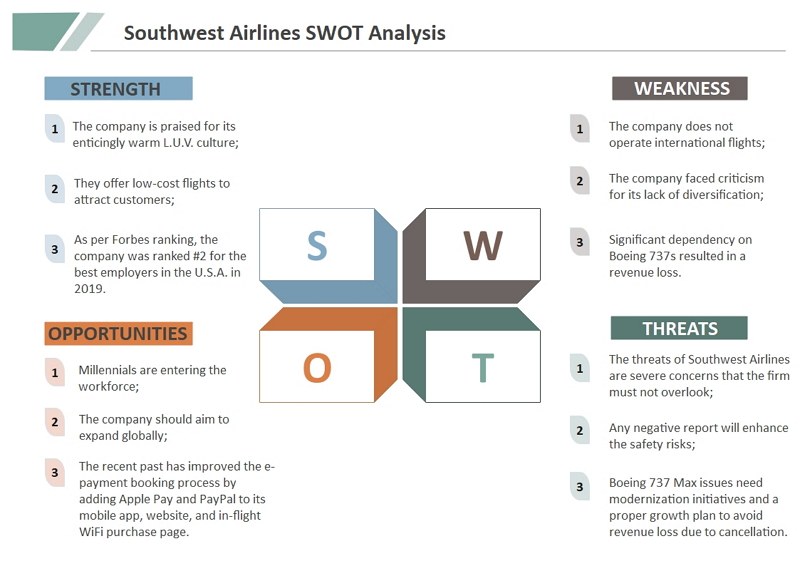
3. Key Takeaways
The Southwest Airlines SWOT analysis points out the fact that the company has numerous scopes to perform better. Undoubtedly, the company is one of the most revered names in the airline industry in the U.S.A. Still, Southwest Airlines can maintain its success in the financial sector by adopting a few measures:
- It should diversify the revenue sources to avoid any major catastrophe for the airlines;
- It should increase the number of aircraft models without depending on Boeing 737s alone;
- Faced up with the fierce competition, how to stand out seems far more important for many corporates. Only the innovative technology, expand market share, and improve the service quality, the Southwest Airlines may grow in adverse environment.
Use EdrawMax Online to create a SWOT analysis diagram, or create any other diagram with ease! There are massive SWOT templates and symbols to choose from, and creating a SWOT analysis diagram could be really simple. Also, you can find substantial SWOT templates in our template community to have a quick start.

An In-Depth SWOT Analysis of Wells Fargo

An In-Depth SWOT Analysis of Toyota

An In-Depth SWOT Analysis of Johnson & Johnson

An In-Depth SWOT Analysis of Whole Foods

An In-Depth SWOT Analysis of Home Depot

An In-Depth SWOT Analysis of FedEx


IMAGES
COMMENTS
This Southwest Airlines SWOT analysis provides critical insight into the company's strategies, operations, and market position, making it essential for stakeholders, investors, and competitors. Southwest Airlines, founded in 1967 by Herb Kelleher and Rollin King, has transformed the aviation landscape with its low-cost, point-to-point service ...
A Southwest aircraft at Bob Hope Airport, Burbank, Los Angeles, California. This SWOT analysis of Southwest Airlines identifies global growth and expansion opportunities that the company can exploit. (Photo: Public Domain) Southwest Airlines' operations as one of the biggest low-cost carriers in the world showcase how the company's ...
Southwest Airlines has consistently been ranked as one of the best employers in America. According to recent Forbes ranking, Southwest Airlines is ranked #2 America's Best Employers 2019. 4. World's Most Admired Company. In 2019, Southwest Airlines was ranked #11 Fortune's most admired company in the world. 5.
Southwest's operating revenue fell from $22.4 billion in 2019 to $9 billion in 2020. As a result of this 59% drop, the company had to take aggressive measures to stay relevant. Volatile Fuel Prices: Last year, Southwest spent $1.8 billion on fuel. This expense is 14% of the total operating costs.
SWOT Analysis Examples 2024. As the airline industry continues to thrive and evolve, companies need to position themselves strategically to remain competitive. Southwest Airlines, one of the industry's global giants, is no exception. In this article, we delve into the heart of this American empire through an in-depth SWOT analysis.
The SWOT analysis for Southwest Airlines is presented below: Strengths. Weaknesses. 1. Good profitability, revenue growth and a strong brand image. 2. A robust network and highest domestic market share. 3. Lowest operating cost in the airline industry.
Here is a SWOT analysis for Southwest Airlines: A SWOT analysis is a strategic planning tool used to evaluate the Strengths, Weaknesses, Opportunities, and Threats of a business, project, or individual. It involves identifying the internal and external factors that can affect a venture's success or failure and analyzing them to develop a ...
Southwest's average domestic fare was $142 in 2022, lower than the average $397 for all U.S. airlines, which helped Southwest to remain a popular choice for budget-conscious travelers. Steady Finance: The airline reported revenue of $23.8 B and a net income of $723 M in 2022.
Southwest Airlines is a renowned American low-cost carrier that has revolutionized the airline industry with its unique business model and customer-centric approach. In this blog article, we will delve into the intricacies of Southwest's business model, highlighting its key strengths, weaknesses, opportunities, and threats through a SWOT analysis.
Southwest Airlines Strengths 1. Financial wherewithal. During 2Q2014 Southwest recorded its fifth consecutive quarter of record profits. Its consistent profitability and balance sheet strength have resulted in the airline holding the position of the only US airline to achieve investment grade status until Alaska Air Group secured that coveted position earlier in 2014.
Southwest airlines have a US domestic market share of 16.8%, making it rank third. The first and second are the American and Delta airlines with 17.6% and 17.5%, respectively. Weaknesses Operational Costs Affecting Net Income. Southwest Airlines has attracted more customers than its rivals by reducing costs.
A meticulous SWOT Analysis of Southwest Airlines. Southwest Airlines's strengths. Strong financials-Southwest Airlines has abundant financial resources with its revenue in 2021 increasing by a huge margin of 74.5% to $15.8 billion.Further, the company had net cash of $4.8 billion which can help it overcome negative situations and exploit new opportunities (Southwest 2022).
The graph above covering the period January to December 2020 showcases that the top 4 airlines constitute approx. 65% of the market share. In this story, we are focusing on Southwest Airlines that was founded on the notions of the low-cost carrier but with its unique strategy has been profitable for the last 45 years in a row.
Southwest Airlines is well-known for its low-cost and reliable service, which has resulted in a loyal customer base and high customer satisfaction ratings ( Pestle Analysis ). The airline's commitment to providing a positive travel experience has earned it a strong reputation among travelers. Southwest Airlines understands the importance of ...
Southwest Airlines' SWOT Analysis. Below, there is a detailed swot analysis of Southwest Airlines: Southwest Airlines' Strengths. Low prices: It offers flights overseas — which means, not just across the U.S., but also to the Caribbean and some Latin American countries — for lower pricing than the big companies;
Prior to COVID-19, Southwest Airlines has achieved a 1 percent growth in the Goss margin from 68. percent in 2018to 69percent in 2019. However, the gross margindeclinedby11percent to59percent in ...
A short description about the Southwest Airlines. Southwest Airlines (initially known as Air Southwest) launched its first flight in 1971. Its founders were Herb Kelleher and Rollin King. By then, the company only served three cities within US (Houston, San Antonio, and Dallas) and had not expanded its operations beyond the country.
The business strengths and competitive advantages identified in the SWOT analysis of Southwest Airlines Co. attract customers and support the success of market penetration. The strong airline brand and attractive prices enable this intensive growth strategy. ... Tags: Case Study & Case Analysis, Civil Aviation, Generic Strategy (Porter's Model ...
The airline industry's stringent regulations threaten the company. Source: EdrawMax Online. 3. Key Takeaways. The Southwest Airlines SWOT analysis points out the fact that the company has numerous scopes to perform better. Undoubtedly, the company is one of the most revered names in the airline industry in the U.S.A.
Abstract. Southwest Airlines is a leading low-cost airline based at Dallas International Airport in the US. It was founded by Herb Kelleheri in 1967 (Ondracek et al., 2021).It is one of the world ...
The primary industry Southwest Airlines operates in is the airline industry, which is estimated to be worth an estimated $715 billion USD in 2020. This industry employs approximately 1.3 million people, with the majority of these employees based in the US, followed by the UK, Japan and Germany.
Dr. Ashutosh Muduli. Ms. Vinita Kaura. Southwest Airlines Success : A Case Study Analysis. customer' s level of satisfaction, repurchase. decisio ns and word o f mouth publici ty. Southwest ...
Southwest Airlines Case Stud1 SWOT Analysis - Read online for free.